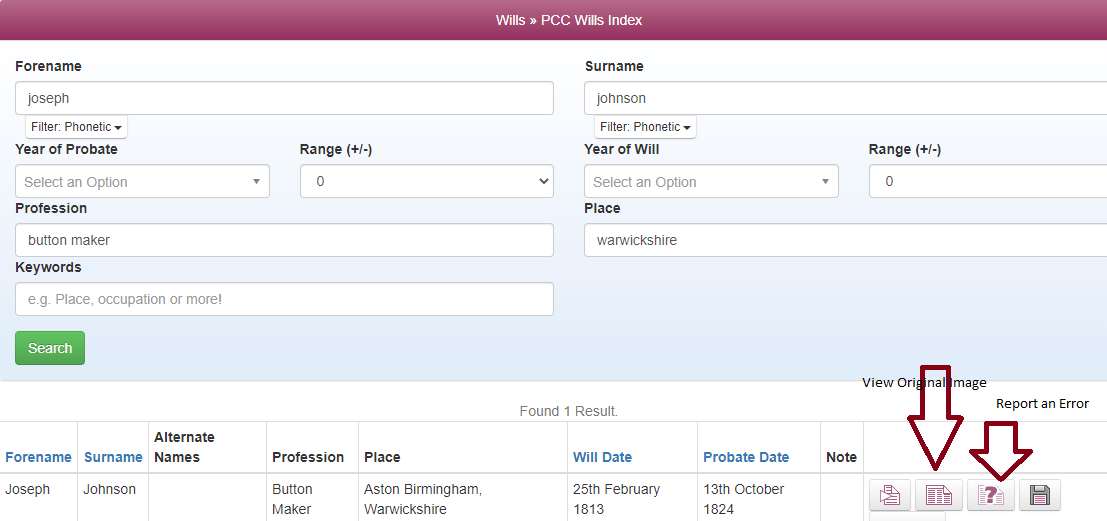Overview of available Databases
Discover Your Ancestors
Discover Your Ancestors Periodical is a high quality monthly digital magazine delivered to your personal online library every month. Packed full of stories, case studies, social history articles and research advice, this regular and affordable service is a must have for anyone starting out in family history research, or for those with more experience but who have reached brick walls.
Expert guidance and inspiration around historic themes merge to create an informative and educational guide through your journey of research. It’s really easy to read, too. We have created the product in a web ready format, so whether you are viewing on a PC or MAC or mobile device, or you simply wish to print an article – it is available for you.
For subscribers to Discover Your Ancestors Periodical, click on the ‘View’ button next to Discover Your Ancestors logo to be taken to a page where you can view each issue.
Adoption Service
This is an index to all adoptions granted by courts in England and Wales since 1927. A birth entry was made in this index when a court issued an adoption order.
The entry will replace the original birth entry, and also instructs the GRO (General Register Office) to mark the original birth entry as 'adopted'.
Searching for an adoption and getting the references is just the first stage in the process of finding the birth parents.
If you are the child you are required to attend an informal meeting with an approved adoption advisor for confidential guidance, either with your local Social Services, at the General Register Office or, under certain circumstances, at the agency that handled your adoption.
You can also choose to see an adoption worker at another local authority. The General Register Office will forward your original birth information to your chosen approved adoption advisor.
More information can be found on gro.gov.uk or direct.gov.uk
Due to the sensitive nature of adoptions, we do not provide direct access to adoption records. We instead pass your adoption search criteria on to an adoption search expert who will also give advice on the next steps to take. This expert is under contractual obligation to protect your personal data in accordance with our privacy policy.
If you would like to purchase an adoption lookup please fill in the form giving as many details as possible, the form can by located by clicking on the 'Search' tab then choose 'Find Records' from the drop down menu and click on the Adoption Search Service button below the Master Search.
1939 Register
At the outbreak of World War II, the government urgently needed an up to date list of all the population to begin instituting the measures it would need for conscription and the introduction of ration books and identity cards.This couldn't wait for the next census that was scheduled for 1941 so the solution was to take a survey of all the private citizens on 29th September 1939 and create what we know today as the 1939 Register. The resulting roll would provide the authorities with a snapshot of the civilian population of England and Wales just after the outbreak of the Second World War and today is of immense use to family historians looking for their forebears in this period.
The 1939 Register is made all the more important by the fact that the 1931 census for England and Wales was destroyed by fire during the Second World War and no census was actually taken in 1941. The Register, therefore, provides us with the most complete survey of the population of England and Wales between 1921 and 1951 which makes it an invaluable resource for all family, social and local historians. While the 1939 Register is not a census, it is arranged along similar lines and includes similar information, though this is less detailed. What it does better than a census, however, is show researchers the exact dates of birth where census returns just give a person's age. It continued to be updated until 1951 and afterwards by the NHS from its inception in 1948 until they began to transfer their records to computers in 1991.
The massive survey that was undertaken to create the Register was intended to record the details of every member of the civilian population on a specific date – military personnel were not recorded as the registration of members of the armed forces was dealt with by the military authorities. While the 1939 Register, therefore, does not include service personnel who were either in army, naval and air force establishments on the 29th September, or even military personnel who were resident or visiting their own home at the time, it does record people who would go on to serve in the armed forces at a later date. This is because in September 1939 conscription had not yet begun; compulsory enlistment was actually to start in October of that year.
We have released the 1939 Register transcript, adding our unique and powerful search tools and SmartSearch technology. This offers a hugely flexible way to look for your ancestors at the start of the Second World War.
Our brick wall shattering search tools include the ability to find your ancestor in 1939 by using keywords, such as the individual's occupation or their date of birth. You can also search for an address and then jump straight to the household. If you're struggling to find a family, you can even search using as many of their fore names as you know.
Once you've found a record in the 1939 Register, you can click on the street name to view all the residents on the street, potentially finding relatives living nearby.
Take your research journey quickly forwards by using our innovative SmartSearch to jump to a person's birth, marriage or death record.
You can access the 1939 Register from the Master Search page by selecting ‘1939 Register’ from the Record Collection drop down menu:

You can also use our advanced search facility which includes additional search fields to narrow down results. You can access this by clicking the 'Search' tab along the top of the website and choose 'Find Records' from the drop down menu. Scroll down the page below the Master Search and select '1939 Register’ from the list of databases:
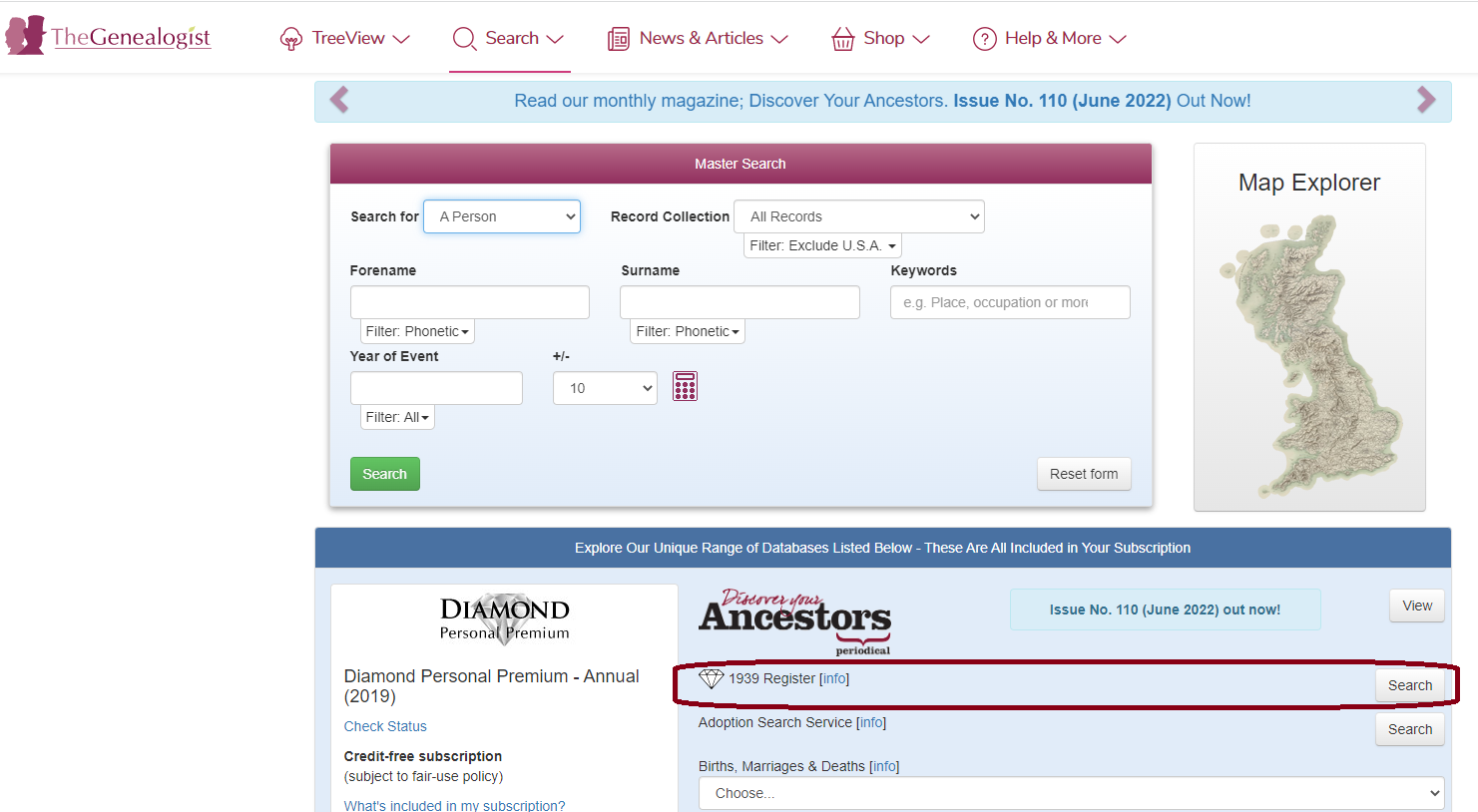
Additional fields such as Day, Month of Birth and address can be entered:
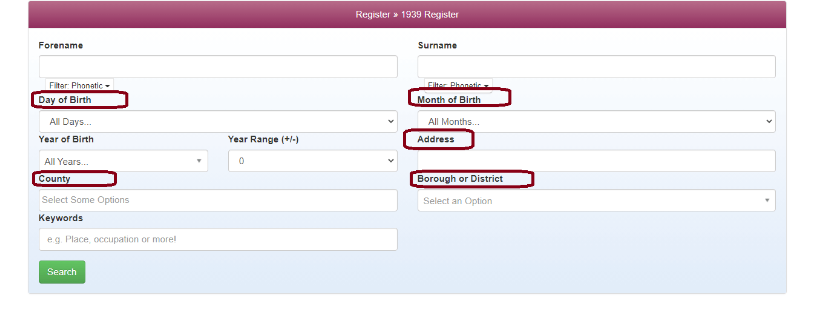
When you obtain the required results, click on the icon as indicated below to view the Transcription:

SmartSearch features to see a Birth, Marriage or Death entry for the individual can be accessed here:
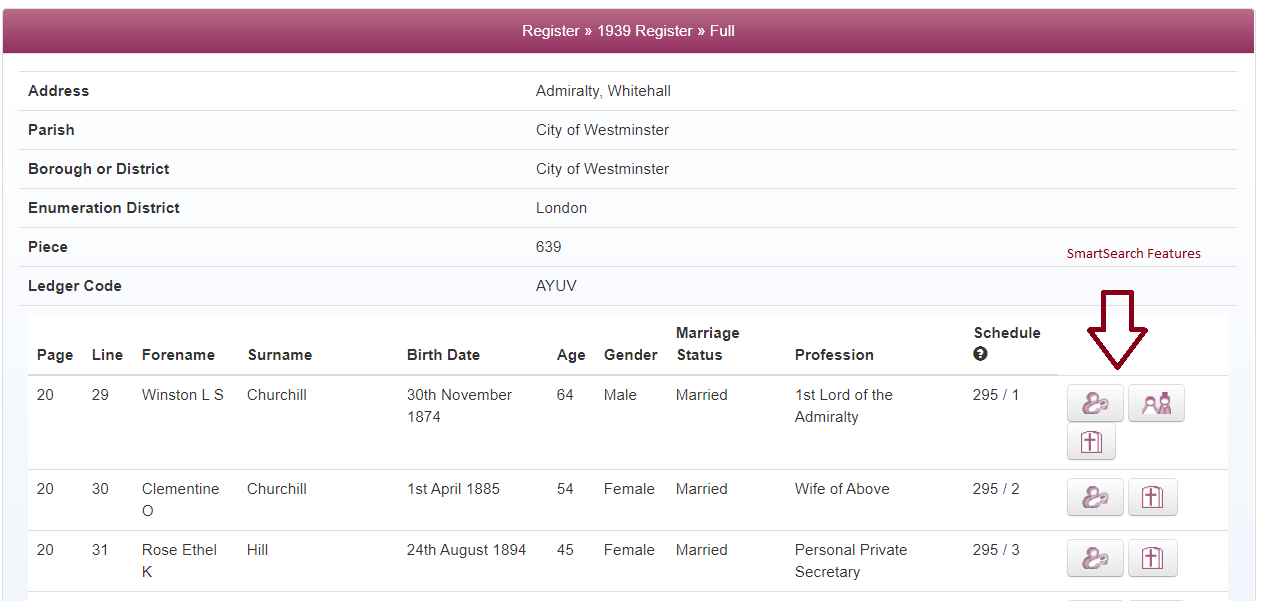
Births, Marriages and Deaths
Civil Registration Birth Marriage and Death Records
Civil Registration was introduced in 1837 to record Births, Marriages and Deaths, which had not previously been centrally registered. Like the census, its introduction had much to do with monitoring the growth and age profile of the country's population. (Previously, the only records were the parish records kept by the church.)
The General Registry Office (GRO) was in charge of collecting and collating this data and they created quarterly indexes to Birth, Marriage and Death registrations. Registration certificates are a key resource in family history research.
You cannot view the original register entries but you can purchase copies of the certificates. The GRO indexes are used to locate the references necessary to order certificates.
Commencing with the introduction of Civil Registration in 1837, the indexes enable us to locate the dates of family events and purchase the certificates necessary to carry out our research. The Birth, Marriage & Death indexes are fully searchable online and you can achieve in a day what may have taken you months or even years previously. The GRO provide online certificate ordering, including PDF options for some events.
What can I see on the BMD Indexes
Although the certificates themselves provide a wealth of knowledge, the indexes provide very little, just an Event, Name, Year, Quarter and Page number. You may also find the reported age at death, the surname of the spouse (1912 onwards) or a mother's maiden name on later birth entries after 1912. Records are a little patchy in the early years, especially if you are looking at births because initially registration was voluntary.
Early indexes contain just the name and reference, but extra information was later added to the indexes to help locate the correct individual. The Age at Death was included in the Death indexes from 1866 and from 1912 the surname of the spouse was added to the Marriages and the maiden name of the mother to Births.
The post-1984 BMDs contain re-registration entries, where details have been updated at a later date. There will be a date of re-registration in the original entry, however, there is no indication in the later entry that it is a re-registration so we are unable to highlight it as such.
What information can I see on a Birth Marriage or Death Certificate
Information in a Full Birth Certificate
This will give you date and place of birth, full name and maiden surname of the mother, forename(s) and sex of the child, the informant's name, address and relationship to the child, full name and occupation of the father if married to the mother (or if he attended with the mother and signed the registration entry) from 1969, the place of birth of both parents.
Information in a Marriage Certificate
This will give you; date and place of marriage, marital status of the bride and groom whether by banns, licence or certificate, current address and occupation of the bride and groom, names and ages of the bride and groom names and occupations of their fathers ('full age' indicates that the person was over 21) names of witnesses.
Information in a Death Certificate
This will give you; name of the deceased, occupation, or the name and occupation of the husband, if a married or widowed woman date and place of death name, address and family relationship if any of the informant, given age date and place of birth, usual address and maiden name if a married or widowed woman (but only from 1 April 1969) cause(s) of death.
Ordering certificates
Certificates for births, marriages or deaths in England or Wales can be ordered online through the GRO. To order a certificate, simply follow the instructions on the GRO website, supplying the necessary data and a GRO Index reference. The full reference is usually a volume and page reference or an 'entry number' for later records, given with the year, quarter and district. This can be found by viewing the full record detail when searching BMD records online. Events from the last 50 years will require you to supply more information at application stage.
How to Search the BMDs
You can search the Birth Marriage and Death Indexes from either the Master Search or the Advanced Search option.
Master Search:
From the main Master Search you can select to search All Records which will provide results from all resources. Or you can select Births & Baptisms, Marriages or Deaths & Burials:
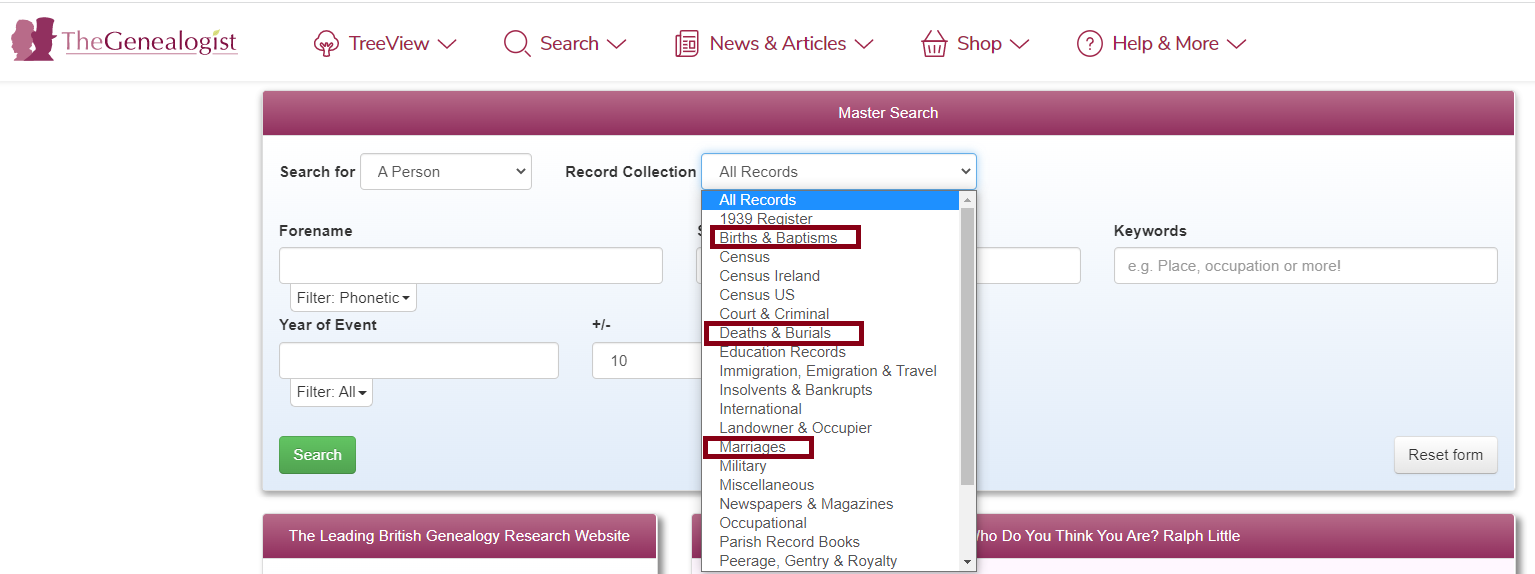
You can then enter the name of the person you are looking for.
In the keyword box you can use additional information to help your search. For example, if you are looking for a Birth you could enter a District or County or Mother's Maiden Name (after 1912). If looking for a marriage you could enter a District or County or Spouses Name (more accurate after 1912).
You can then enter a Year of Event date to search with a +/- Year Range option.
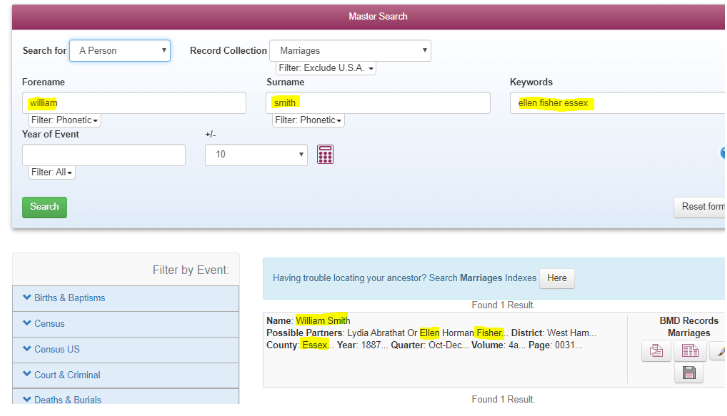
The keyword facility is a really flexible tool and can really help cut the number of potential records to check through.
Sometimes less is more, so if you are entering a few keywords and getting no results perhaps try reducing the number of keywords used.
You will notice there are icons displayed to the right of the results, you can use these to view the Record, view the Image or Save the record.
BMD Advanced Search
If you decide you only wish to search the BMDs you can use a specific search for the BMDs.
From the main Search page, beneath the Master Search you will see Drop Down Menus for our various resources, one of which will be Births Marriages and Deaths:

You will then be taken to a different Search Page where you can select to Search either Births, Marriages or Deaths and then enter various fields of data:

Results displayed from this Search page will still display the icons for you to go on and view the Record and Image.
SmartSearch
We have introduced a number of SmartSearch facilities to assist you when researching.
For example when searching the Birth Index records you will see two SmartSearch icons:

The first one will allow you to search for potential siblings based on the year range, surname, district and mothers maiden name. The second icon will allow you to search for a potential marriage of the parents based on the year range and surname and mothers maiden name.
When searching Marriages the SmartSearch option will be:

This will allow you to search for potential children born to this couple. This is based on the year range, surname and spouses surname and district.
When looking at a Death index the SmartSearch option will give you the option to search for a Potential Birth record for that person:

Please Note: The success of the SmartSearch facility can only depend on the information within a record.
For example before 1912 there is no mothers maiden name on births, no spouse's surnames on marriages and no age or date of birth on Death Indexes which means there is less criteria available for the SmartSearch and therefore results will be much less accurate.
Birth Marriage and Death Distribution Maps:
When using the Master Search and looking at the results from the Birth Marriage and Death Indexes (England and Wales 1837-2005) you can view the details on a Map.
This would allow you to see the distribution of the name over the years and see where the surnames are concentrated and how this changes over time.
When looking at your results, on the left hand side you should see the Map option:

This will load a new window:
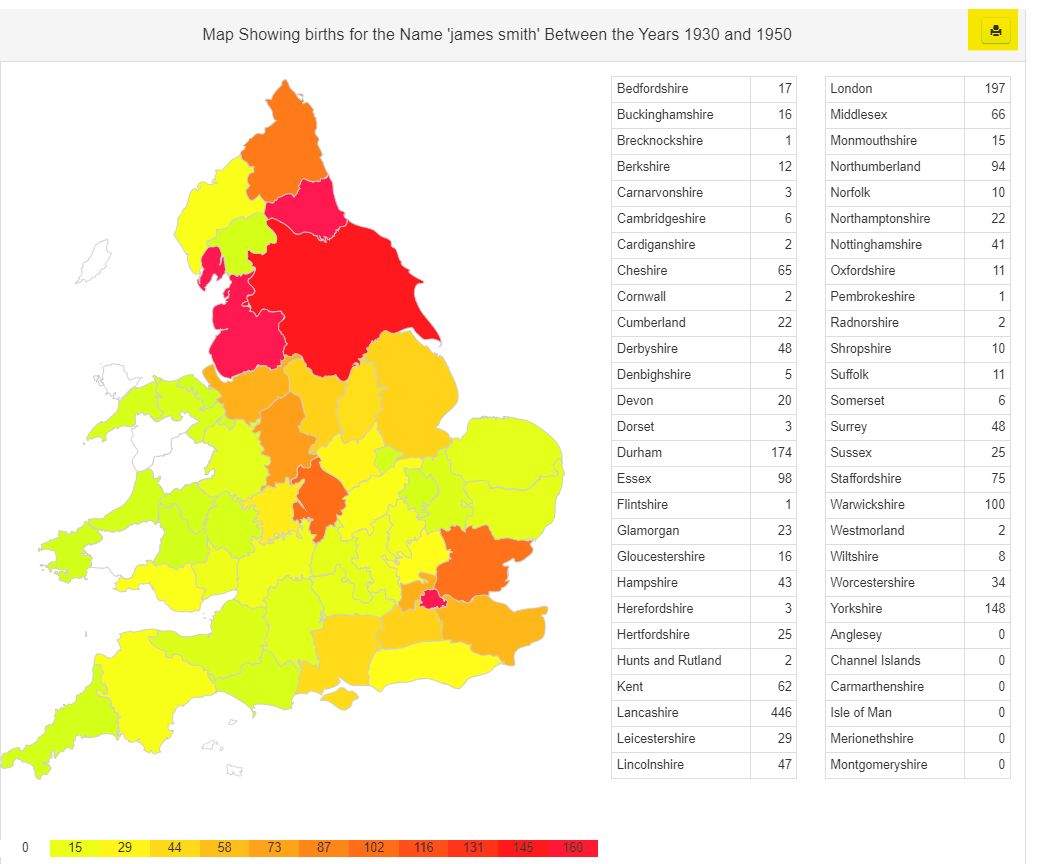
You can also print the map for your record if you wish.
Browsing the Index Pages:
If you would prefer to browse the pages of the index by Year, Quarter and Surname you can still do this rather than use the transcripts.
To access this feature please select BMD Records 1837-2005 from the Drop Down Menu under Births Marriages and Deaths.

From the next page please select Civil Registration Indexes 1837-1983 from the top drop down option:

Please enter your Search Terms; Surname and Year Range and you will then see the pages of the index displayed for you to click and view.
Census Records
TheGenealogist provides access to complete census records for England and Wales 1841-1911. These are fully searchable transcripts with access to the original census pages.
Census Records are taken every 10 years and were completed on the following dates:
1841- 6th June
1851 - 30th March
1861 - 7th April
1871 - 2nd April
1881 - 3rd April
1891 - 5th April
1901 - 31st March
1911 - 2nd April
There were earlier census taken in 1801, 1811, 1821 and 1831 however the lists of names were not collected centrally. You may find that local record offices will hold some of the data.
The later census data is protected for 100 years and is held by The Office of National Statistics where it remains closed to the public until its release date.
What information can you see on the census?
On the 1841 census you will see: Name, Age, Sex, Occupation and Address. Moving onto the 1851 you see the addition of Birth Place, Relation to Head and Marital Status. This format continued for 1851 -1881.
The 1891 added Employment Status and the same was true for 1901.
The 1911 is the most informative to date. It was the first census to be completed by the householder (your ancestors) rather than an enumerator.
It included extra valuable data such as Nationality, Duration of current marriage, Number of Children Born within that Marriage, Number of Children still living and number of children who had died.
The census records are a great starting point for your research. They allow you to discover where and how your ancestors lived at various points in time, what profession they worked in and how many people lived with them at that time. Census records give you a great snapshot of your family every ten years.
TheGenealogist offers access to a full collection of transcripts from 1841 to 1911. Search by name, address, age, occupation our use our ‘Family Forename Search’ to find your matches without entering a surname.
View original images and printable transcripts of the entire household or just family members.
What is the Census?
The census is a statistical exercise undertaken to inform the government, counting and recording facts about the population. You could say that the first large scale census taken in modern history was Domesday and there have been others over the years, such as Muster rolls, taken to see what able-bodied men and weapons were available for war.
A census has been carried out every decade since 1841 (with less comprehensive census taking starting in 1801). The only exception when a census was not taken was in 1941 during the Second World War. Census records were never intended for family historians to use, but as a an exercise in finding out statistics about the population, to enable the government to make accurate and informed decisions on a wide variety of social topics including housing, transport and food, and to identify the strengths and weaknesses in the economy of the country at that point in time. However, their value nowadays as a snapshot in time is now widely recognised as immense for family historians.
What can we find out?
From 1801-1831, purely statistical data was collected with no usable genealogical material, however the 1841 census introduced records with some personal information for the first time. The usefulness of the 1841 census is limited to family historians because it unfortunately didn't accurately record people's ages, or where they were born, only noting if they were born in the same county or not.
Address
Unfortunately not always very accurate, unless your ancestors lived in a named house or farm. You may have to settle for simply knowing the name of the road or the village.
Name
The surname with at least one forename, although it could turn out to be a pet name, and sometimes you find second forenames or initials.
Relationship
How the individual is related to the head of the household. Information providing the structure of the family, especially where married children or relations are included in the household.
Condition
Whether married, widowed or single. Again useful in establishing family structure.
Age
From 1851 onwards, these are usually as accurate as your ancestors were able or prepared to supply. In the 1841 census they were usually rounded to the nearest 5 years for adults.
Occupation
The rank, profession or occupation can be useful in helping to establish that you have found the correct person, especially if they share a relatively common name.
Where born
Another field that is useful in helping you identify individuals, although for a number of reasons it frequently contains mistakes.
In addition to the above, the 1911 Census was the first to include the number of years a couple had been married and how many children had been born to that marriage.
Search Tips
- The census gives us a snapshot of an exact moment in time. It was designed to record all members of a household resident on census night and this would include any travellers or visitors.
- Be aware of enumerator errors, misspellings of surnames, first names etc can throw a researcher off the scent.
- The phonetic search on TheGenealogist assists with spelling errors in census recording. If a name sounds the same it will be picked up when searching on TheGenealogist, although it may be spelt differently.
- In 1851, ships in port or in British waters were treated like institutions and enumerated separately. Crews of ships at sea or in foreign ports were not counted in 1841 and 1851. Starting in 1861, special shipping schedules were used to account for all British vessels anywhere at sea.
- The census is also a great way of discovering other family members. TheGenealogist offers a Family Forename Search which allows you to search by family members you know exist, even without a surname.
- The Street Search on TheGenealogist also allows you to view the inhabitants of a particular street at census time. Be aware many of our ancestors lived close to each other so it’s a great way of discovering other extended family members.
- Using the census records, now you have their address, you can discover more about them. Looking at local parish records, look for churches and cemeteries, there may be records of your ancestors.
Scottish Census
We can provide access to the Scottish Census Transcripts for 1841-1901.
These are searchable via our MasterSearch facility.
If you are having difficulties locating your Ancestor in the Census records it could be that they are there but you haven't found them yet. Allow for mis spellings and mis transcriptions - the wild card facility is a useful tool for this. They could be missing from the Census altogether or in a part of the Census that has since gone missing. You can get an idea of which parts of a Census are missing by searching in 'Discovery', The National Archives online catalogue. This will enable you to discover if a Parish is missing. Below is a useful link relating to missing Census pages:
https://blog.nationalarchives.gov.uk/missing-from-the-census/
Change of Names
This searchable database is great for family historians wanting to find ancestors who officially changed their forename or surname in Britain. The Change of Names Database covers information gathered from a number of sources including Private Acts of Parliament; Royal Licenses published in the London and Dublin Gazettes; notices of changes of name published in The Times after 1861 with a few notices from other newspapers; registers of the Lord Lyon (King of Arms) where Scottish changes of name were commonly recorded; records in the office of the Ulster King at Arms and also some private information.
These fully searchable records allow researchers to:
- Break ‘Brick Walls’ in your research
- Discover ancestors that recorded a change of name
- Find out what name had been adopted and the name discarded
The database can be accessed using the advanced search facility; you can access this by clicking on the ‘Search’ tab along the top of the website and choose 'Find Records' from the drop down menu. Scroll down the page for a list of databases, and choose ‘Change of Names’ from the ‘Miscellaneous Records’ drop down menu:

You will then be directed to the search screen with the facility to search either by the discarded or adopted name:

Court and Criminal Registers
Court rolls and criminal records can provide a wealth of interesting and unique information for family history researchers, with details of property, possessions and family members as well as crimes that had been committed.
The best way to access TheGenealogist’s ever growing collection of Court and Criminal records is to use our advanced search facility, you can access this easily by clicking on the ‘Search’ tab along the top of the website as shown below and choose 'Find Records' from the drop down menu:

You will then need to choose one of the following options;
- ‘Convict Transportation Registers’
- ‘Court and Criminal Book Records’
- ‘Criminal Records’

Currently available:
Transcript Records
Convict Transportation Records:
TheGenealogist provides access to early court rolls from 1394, and registers of convicts sent to Australia between 1787 and 1867.
HO 10
Home Office: Settlers and Convicts, New South Wales and Tasmania: Records
1787-1859
- Lists of the male and female convicts and former convicts in the colonies giving particulars as to their sentences, employment, settlement in the country, the land and cattle acquired by them and other information
- List of Convicts
- List of Convicts Tasmania
- First Fleet
- Ledger Returns
- Pardons granted:
- Tickets of Leave
- New South Wales
- Tasmania
- General muster
- Census of 1828 relating to settlers and convicts
HO 11
Home Office: Convict Transportation Registers
1787-1870
British Convict Transportation Registers from 1787 to 1867, with details of over 123,000 of the estimated 160,000 convicts transported to Australia during the 18th and 19th centuries. Includes name, place of trial, years sentenced, name of ship, date of departure and more.
The records mainly include those convicted in England, Wales and Scotland, but also include a small number of Irish convicts. The database also includes soldiers who had been court-martialled and sentenced to transportation. These 'soldier convicts' may have been convicted in various British colonies including the West Indies, India, Pakistan and Canada.
The prisoners on these registers were sent to New South Wales, Van Diemen's Land (Tasmania), Moreton Bay (Brisbane), Port Phillip. Western Australia and Norfolk Island. Also recorded are some ships which were bound for Gibraltar and Bermuda.
Court and Criminal Book Records
The Court Rolls of Tooting Beck Manor Vol.1 1394-1422
Worcestershire County Records - Calendar of the Quarter Sessions 1591-1643
Court Rolls of the Manor of Hornsey 1603-1701
Lancashire – Manchester Constables Accounts Vol. 1 1612-1633
Lancashire – Manchester Constables Accounts Vol. 2 1633-1647
Lancashire – Manchester Constables Accounts Vol. 3 1743-1776
Middlesex County Records Sessions Rolls Vol I 1549-1602
Worcester Quarter sessions Vol 1, Part 1 1591-1620
Middlesex County Records Volume II 1603-1625
Warwick County Records Vol I - Quarter sessions order book easter, 1625, to trinity, 1637
Warwick County Records Vol II - Quarter sessions order book michaelmas, 1637, to epiphany, 1650
Warwick County Records Vol III - Quarter sessions order book easter, to epiphany, 1657
Warwick County Records Vol V - orders made at quarter sessions easter, 1665, to epiphany, 1674
Warwick County Records Vol VI - Sessions Indictment Book 1631-1674
Warwick County Records Vol VII - Proceedings in Quarter Sessions 1674-1682
Middlesex County Records Sessions Rolls and Book Vol III 1625-1666
Middlesex County Records, Books and Certificates Volume IV 1667-1689
Shropshire, Quarter Sessions Rolls 1801-1820 (Jan)
Surrey, Quarter Sessions with other Records of The Justices of Peace Vol V
Smuggling in Sussex
Criminal Records
After selecting the ‘Criminal Records’ option from the Advanced Search you will be greeted by the following screen which will allow you to search by the usual forename and surname as well as by record (eg: HO24 could be selected from the list of options for prisoners at Millbank, Pankhurst or Pentonville prisons). You can also search by the offence or Individual Type, eg: Offender or Victim and use details such as piece/year/keywords to narrow down results;
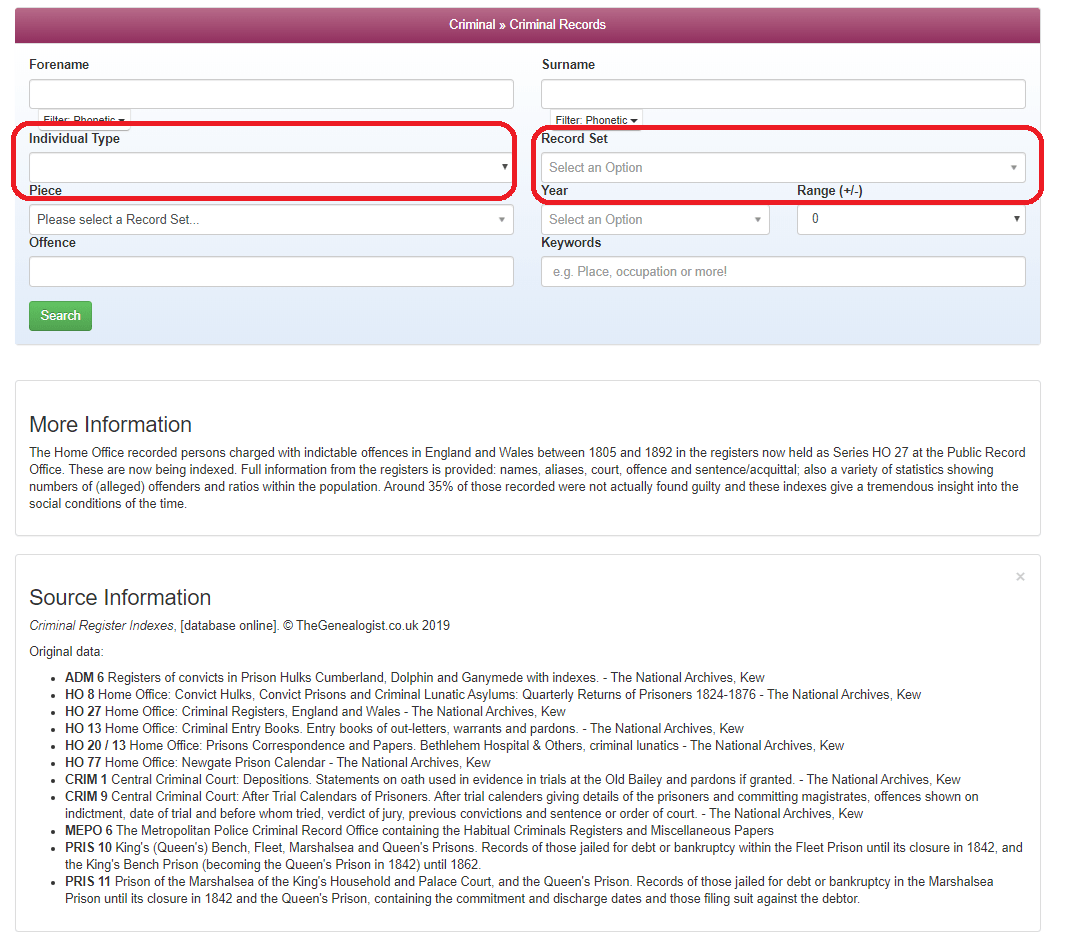
- ADM 6 Registers of convicts in Prison Hulks Cumberland, Dolphin and Ganymede with indexes
- HO 27 Home Office: Criminal Registers, England and Wales - The National Archives, Kew
- HO 13 Home Office: Criminal Entry Books. Entry books of out-letters, warrants and pardons. - The National Archives, Kew
- HO 20 / 13 Home Office: Prisons Correspondence and Papers. Bethlehem Hospital & Others, criminal lunatics - The National Archives, Kew
- HO 77 Home Office: Newgate Prison Calendar - The National Archives, Kew
- CRIM 1 Central Criminal Court: Depositions. Statements on oath used in evidence in trials at the Old Bailey and pardons if granted. - The National Archives, Kew
- HO 24
The release of the HO 24 registers of prisoners in Millbank, Parkhurst and Pentonville prisons allows us to discover information on each prisoner that had been recorded. Details that can be gleaned vary but usually includes their age, marital status, whether they can read or write, their trade, when and where they were convicted, their crime, the sentence they were serving, where and whence received, previous offences, when removed and where to.
Millbank Prison
Millbank Prison had been a prison in the area of London by the same name and was opened in 1816 and eventually closed in 1890.
For part of its history it served as a holding facility where the authorities sent convicted prisoners before they were transported to Australia.
Parkhurst Prison
Parkhurst prison on the Isle of Wight was opened in December 1838 as a prison for young male offenders, most of whom were aged 16 and under. Between 1863 and 1864, it was then converted into a temporary female convict establishment before in 1869 the women were removed to a new prison built at Woking. At this stage Parkhurst then became a prison for male convicts.
Pentonville Prison
Pentonville was then built in 1842 in North London and its design was a development of the system used at Millbank. With the reduction in transportation of convicts to Australia and the cutting back in the number of crimes which attracted the death penalty, the prison population was increasing at this time
- PRIS 10 & 11
TheGenealogist's latest release of criminal records in association with The National Archives reveals the far too often circumstances of the poor. In the eighteenth and nineteenth centuries, 10,000 people a year were being imprisoned for debts and many were trapped indefinitely in the prisons as they were not released until their debts were paid in full.
These records will give family historians details of those imprisoned in the Debtors prisons including the King’s Bench Prison, Fleet, Marshalsea and Queen’s Prisons. These contain commitment and discharge records, giving details of names of the debtor, creditor and attorney, along with the amount of debt.
- PRIS 10 King's (Queen's) Bench, Fleet, Marshalsea and Queen's Prisons. Records of those jailed for debt or bankruptcy within the Fleet Prison until its closure in 1842, and the King's Bench Prison (becoming the Queen's Prison in 1842) until 1862.
- PRIS 11 Prison of the Marshalsea of the King's Household and Palace Court, and the Queen's Prison. Records of those jailed for debt or bankruptcy in the Marshalsea Prison until its closure in 1842 and the Queen's Prison, containing the commitment and discharge dates and those filing suit against the debtor.
The debtors prison was often a life sentence, with many children being born to inmates whilst incarcerated. The Fleet prison even allowed marriages to be carried out by clergy held in the prison, so inmates and others could avoid the normal charges and banns being read. These records are available to search on TheGenealogist as part of the Non-Conformist record collection.
- HO 8
Over 700,000 entries for prisoners sourced from the HO 8 Registers held by The National Archives containing records from the years 1821 to 1876. These Prison Registers give details of ancestors who were imprisoned in a number of convict prisons from Broadmoor to the Warrior Convict Hulk. The records reveal the names of prisoners, offences the prisoner had been convicted for, the date of their trial and where they were tried.
Use the quarterly prison registers to:
- Find ancestors guilty of crimes ranging from theft, highway robbery and libel to murder
- Discover the sentences received
- See the age of a prisoner
- Find out where they were sentenced and to which prison they were sent
Prisoners that have been sentenced in courts from across England, Scotland and Wales can be found in these records. There are also a number tried in British military outposts such as Malta, Gibraltar and St Helena and sent back home to be imprisoned in a convict prison such as Brixton, Fulham, Portland or Portsmouth, as well as the Criminal Lunatics who ended up in Broadmoor.
- HO 26
Contains almost 150,000 entries for prisoners held a Newgate prison, detailing the names of the prisoners, offences the prisoner had been convicted for, the date of their trial and where they were tried. The records also provide the name of the victims and any aliases they were know by, sourced from the HO 26 Newgate Prison Registers held by The National Archives, these documents were created over the years 1791 to 1849.
- CRIM 9
Central Criminal Court: After Trial Calendars of Prisoners. These documents were created by the Central Criminal Court and document the After Trial Calendar of Prisoners.
After Trial Calendars give family history researchers details of ancestors who were up before the Old Bailey, revealing the names of the prisoners that had appeared before the court, the committing magistrates, offences the prisoner had been indicated for, the date of their trial, the records give the verdict of the jury, previous convictions and the sentence or order of the court. Other information in these records include the names of the victim and the level of education or ‘Degree of Instruction’ as well as false names that the criminals may have used to try and hide their tracks from the authorities.
- Find ancestors accused of crimes ranging from stealing to murder.
- Discover people standing trial as forgers, baby farmers, German spies and more.
- Uncover some of the aliases adopted by criminal ancestors to help aid research.
- See the occupation or trade of the offender.
- Research records covering the period 1855-1915
- MEPO 6
The Metropolitan Police Criminal Record Office containing the Habitual Criminals Registers and Miscellaneous Papers.
These are high quality transcripts with original colour images of the registers, as well as registers created by the Police to supervise released criminals - including spies! Entries can contain a description of the individual, dates of conviction or discharge from prison and even the places they frequent!
One of the most interesting features of these records are the photographic portraits taken from the Registers of Habitual Drunkards. These registers feature two photographs, face on and in profile, per individual. Some records may also give distinguishing features, the name of the prison, length of sentence and previous convictions.
Education Records
School, College and University registers are available to Gold and Diamond Premium subscribers with dates ranging from 1220 to 1949, with some records only exclusively available to Diamond subscribers.
While many of our ancestors may not have had the educational opportunities that are the norm today, with higher education available to a wider cross section, sometimes we can come across an ancestor in our research who was privileged enough to go to a Public School or to have attended university. In cases such as this then we can immediately turn to a set of records on TheGenealogist that can add a bit of depth to a family story. They can also reveal leads that will point you in new directions for your research
The fascinating details and glimpses that these provide into the lives of a school pupil or university student can not only include their achievements but often will include some details of the person's family. They can be very useful in confirming birth dates and parents, especially when they have been missed out of other records such as the census. It is a shame that many family historians overlook these lists, as they are a great source of an ancestor’s personal history and may give a clue as to their interests and personality.
Records are bookmarked and can be browsed by page. Our Master Search allows you to enter a forename, surname and any keywords (occupation, street address etc) to bring back potential results.
The best way to search these however is probably via our advanced search, to access these records you will need to click on the ‘Search’ tab along the top of the page and choose 'Find Records' then scroll down the page to the ‘Education Records’ option where you will need to click on the ‘Search’ tab to the right hand side of the screen;
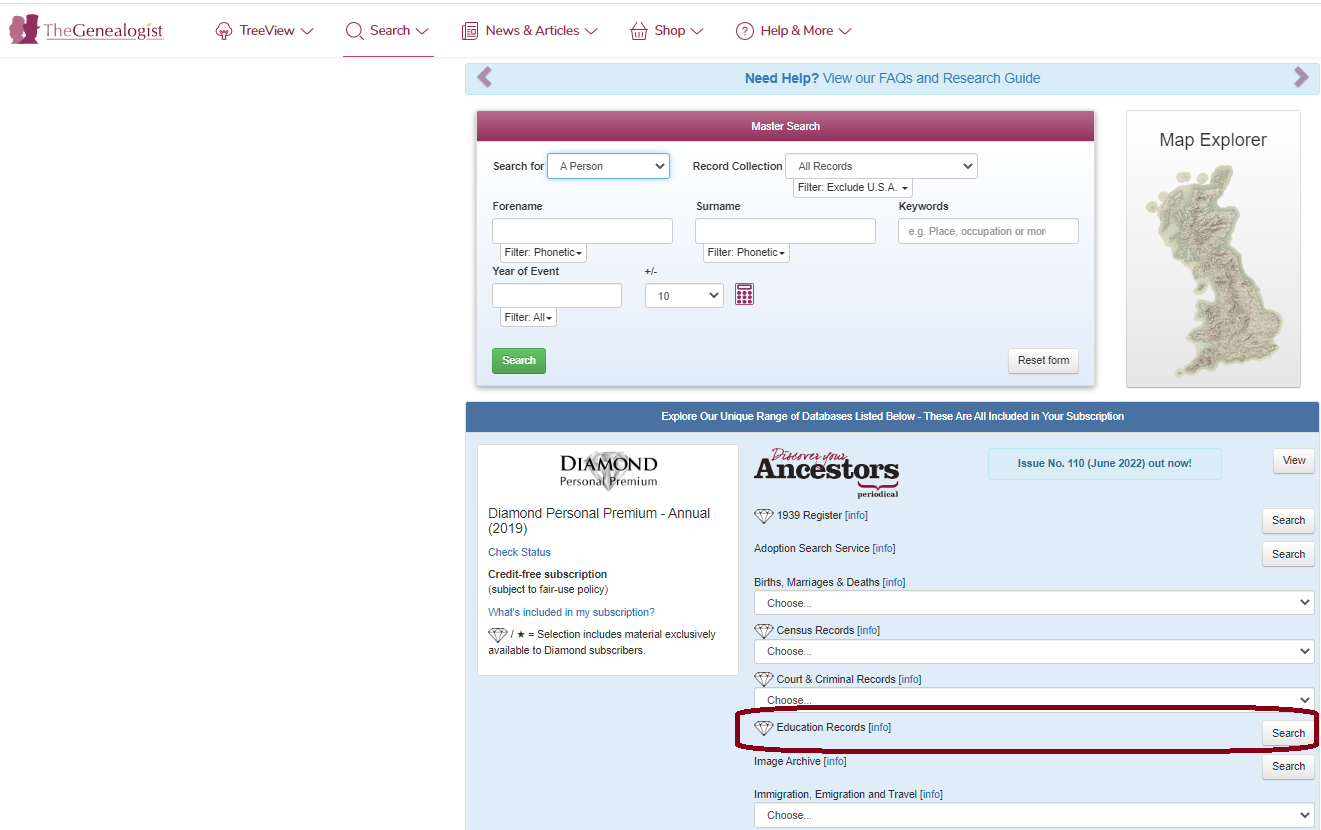
After selecting the ‘Search’ tab this will then take you to a page with the listings of the counties that you can click on and then view the coverage for that county;
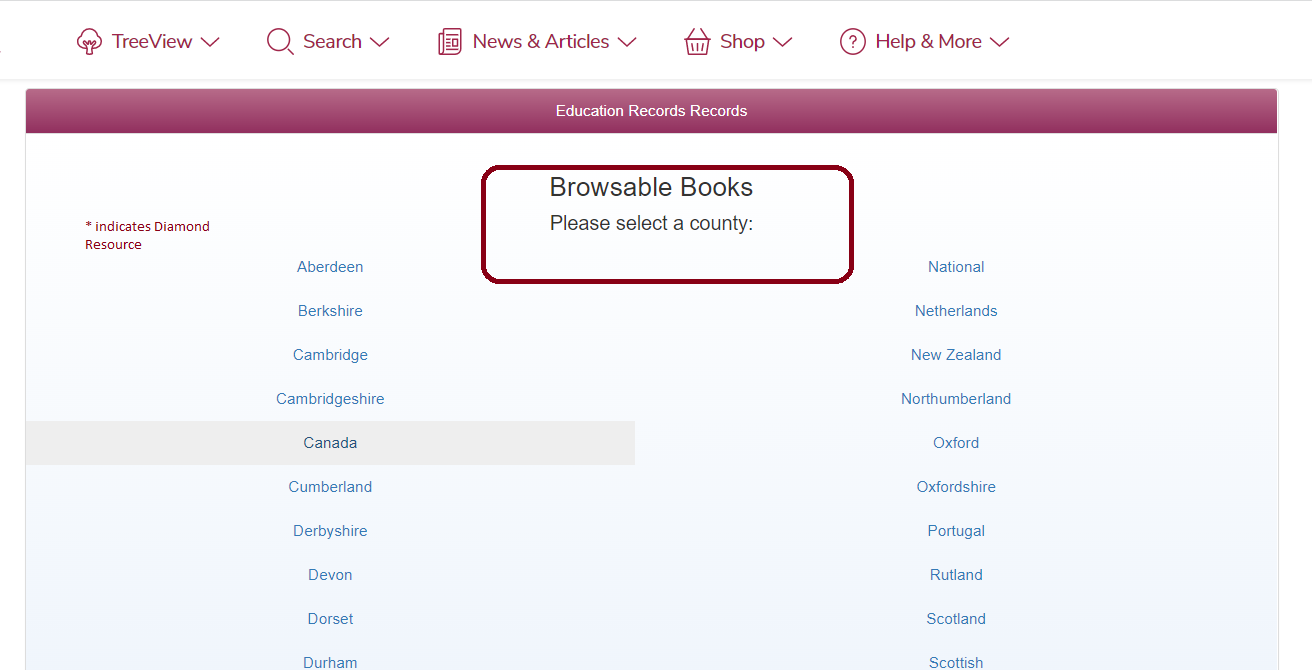
To view a full list of the records available please click here:
https://www.thegenealogist.co.uk/coverage/school-college-university-registers/?type=diamond#includes
Headstones and Headstone Project
Headstones and Church Memorial plaques are a fantastic resource for family historians and we can provide a chance to look at our forebears' graves, and to read the inscriptions that are hopefully still visible.
We can't always visit the cemeteries or churchyards where our ancestors are interred, because our ancestors may have been buried some distance away from where we live. Using our International Headstone Collection you can hopefully find out more from the comfort of your own home.
With more photographs of headstones being regularly added to the collection, which are then transcribed to allow them to become fully searchable, many fascinating discoveries can be made.
From the names and dates carved on a headstone, or a death memorial inside a church, the family historian can then go on to discover yet more about their ancestors by using the clues from the epitaph to then search for them in other records.

These records are searchable via the Master Search and also Advanced Search. The results are displayed with icons to the right which allow you to view the Record, Image of the Headstones and pictures of the Church/Cemetery if available.
The UKIndexer Headstone Project
This is one of our most popular volunteer projects, we are working to photograph and transcribe churchyards from around the world. You can help us build the most comprehensive record of headstones for family research and to preserve the memories these fragile stones provide.
You can decide to help by photographing your local cemetery, opting to just transcribe other volunteers' photographs, or a mix of photographing and transcribing.
"One thing I particularly enjoy in photographing headstones is the peaceful atmosphere of the church and churchyard surroundings. Often people stop to chat, intrigued at what I am doing and then becoming quite enthusiastic when I explain. I thoroughly enjoy photographing the headstones, it's almost bringing people back to life again!"
Lyn, a volunteer from Wiltshire, shares her experience of the project:
This is a great way to get out and see the countryside whilst earning credits towards a genealogy subscription or products.
Please see: https://ukindexer.co.uk/headstone/ for more information.
Immigration, Emigration & Travel
British Naturalisation:
Naturalization basically granted a foreign resident the rights/privileges of a British citizen which was an option for many thousands of people. However, before 1844 this process was granted by a private act of parliament and so would have been a costly process which meant that few could afford this option. Denization on the other hand, although required payment seemed a more affordable option. Those given Denization were subject to certain restrictions such as being unable to inherit land, vote or become an MP they were however able to buy land and property.
As well as providing the date an ancestor may have received British Naturalisation or Denization, other details are provided such as changing their name when they arrived in the UK, records ranging from 1609 to 1960.
Convict Transportation Registers:
HO 10
Home Office: Settlers and Convicts, New South Wales and Tasmania: Records 1787-1859
- Lists of the male and female convicts and former convicts in the colonies giving particulars as to their sentences, employment, settlement in the country, the land and cattle acquired by them and other information
- List of Convicts
- List of Convicts Tasmania
- First Fleet
- Ledger Returns
- Pardons granted:
- Tickets of Leave
- New South Wales
- Tasmania
- General muster
- Census of 1828 relating to settlers and convicts
HO 11
Home Office: Convict Transportation Registers 1787-1870
British Convict Transportation Registers from 1787 to 1867, with details of over 123,000 of the estimated 160,000 convicts transported to Australia during the 18th and 19th centuries. Includes name, place of trial, years sentenced, name of ship, date of departure and more.
The records mainly include those convicted in England, Wales and Scotland, but also include a small number of Irish convicts. The database also includes soldiers who had been court-martialed and sentenced to transportation. These 'soldier convicts' may have been convicted in various British colonies including the West Indies, India, Pakistan and Canada.
The prisoners on these registers were sent to New South Wales, Van Diemen's Land (Tasmania), Moreton Bay (Brisbane), Port Phillip. Western Australia and Norfolk Island. Also recorded are some ships which were bound for Gibraltar and Bermuda.
New Zealand Early Settlers:
Roll of Early Settlers and Descendants In New Zealand
Title, forename, surname, date of birth and date of death are provided for the individual, both for settlers and those subsequently born in New Zealand. The vessel and first place of residence are provided about the settlement. (All information where available)
The settlers, often known as Pakeha settlers, braved the three month sea journey crossing to travel to New Zealand and set up a new life.
Settlement increased significantly from 1837 onwards, in most part due to the setting up of the ‘New Zealand Association’ whose purpose was the colonisation of the country. These aims were achieved through a number of ship voyages and ‘The New Zealand Land Company’ which purchased large areas of land from the Maori. The land was then used as the basis for the new settlements and sold off in parcels to those who immigrated there.
Passenger Lists
- BT27 - Board of Trade: Commercial and Statistical Department and successors: Outwards Passenger Lists
[database online]. TheGenealogist.co.uk 2020
Passenger lists of people leaving from or moving through the United Kingdom by sea kept by the Board of Trade's Commercial and Statistical Department and its successors. Currently covers the years 1896 to 1909.
TheGenealogist has just released over 2.7 million BT27 records for the 1930s. These Outbound Passenger Lists are part of an expanding immigration and emigration record set on TheGenealogist that feature the historical records of passengers who sailed out of United Kingdom ports in the years between 1930 and 1949 and the 1960.
- Records for Passengers Who Arrived at the Port of New York During the Irish Famine created 1977 - 1989, documenting the period 1/12/1846 - 12/31/1851
[database online]. TheGenealogist.co.uk 2020
- New South Wales Emigration
[database online]. TheGenealogist.co.uk 2020
-Germans, Italians & Russians to America 1834 - 1900
The Center for Immigration Research created this series to promote access to information about German, Italian and Russian immigrants to the United States. The information was extracted from ship passenger lists in the records of the U.S. Customs Service (NARA Record Group 36).
[database online]. TheGenealogist.co.uk 2020
Titanic Passenger Lists:
The Titanic was the largest ship afloat at the time of her maiden voyage in 1912. It set sail from Southampton heading first for Cherbourg, Queenstown (Cork) then her fatal leg to New York, carrying over 2200 people, with 1316 passengers and around 900 crew. As well as the wealthy and famous, such as John Jacob Astor IV, Isidor Straus and Benjamin Guggenheim, there were working class people who had given up everything to start a new life in America.
International Records
The best way to access TheGenealogist’s extensive collection of International records is to use our advanced search facility, you can access this easily by clicking on the ‘Search’ tab along the top of the website and choose 'Find Records' from the drop down menu. Then as shown below scroll down underneath the Mastersearch and select the required record set from the ‘International Records’ drop down menu;
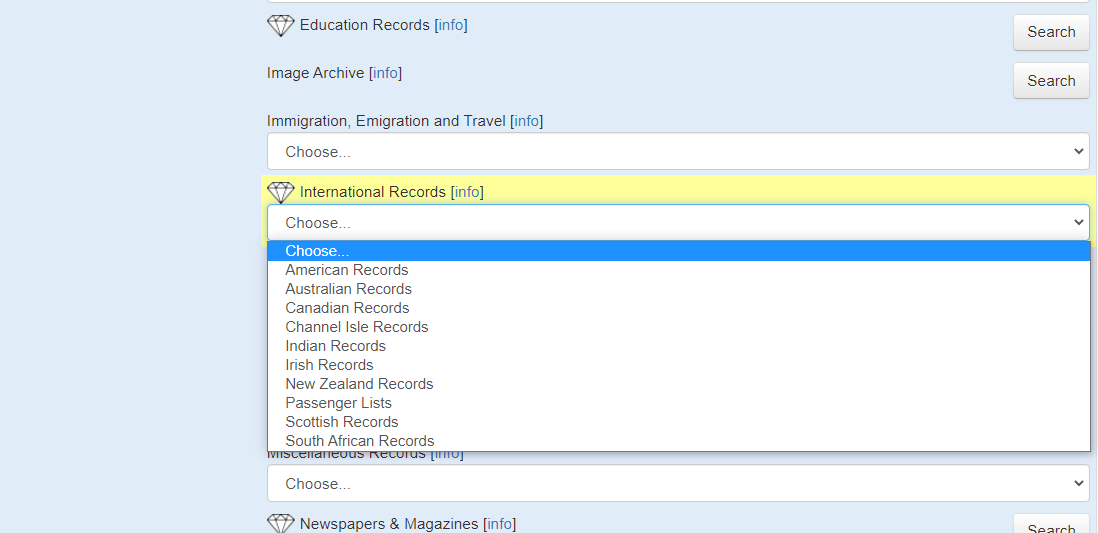
From this drop down menu you should have a variety of options to choose from including American Records, Australian Records, Canadian records as well as records for the whole of Great Britain such as some Irish and Scottish records. The International Records collection is exclusively available to Diamond subscribers.
International records include directories, early passenger lists to America, civil service lists, almanachs, electoral registers and telephone directories.
Databases available to search within the International Records collection:
American Records
A collection of directories, some early passenger lists to America, Directories and an Almanac. Almanachs are annual publications containing data and statistics for the area. Many of these also include residential and business listings, similar to those found in directories. For full coverage of our American records please see check the coverage within our Subscription Coverage Catalogue by clicking here.
Australian Records
-Online access to Convict Transportation Registers 1787-1867. Includes details of convicts transported to Australia during the 18th and 19th centuries. The records mainly include those convicted in England, Wales and Scotland, but also include a small number of Irish convicts, and soldiers who had been court-martialed and sentenced to transportation. These 'soldier convicts' may have been convicted in various British colonies, including the West Indies, Canada, India, and Pakistan.
-Access to the Queensland 1900 Electoral Register and Port Phillip 1849 Electoral Register as well as
Canadian Records
Channel Isle Records
We have also added directories, almanachs, pedigree and roll of honour records for the Channel Isles.
Indian Records
Irish Records
Irish records include directories, wills, land owner and heraldry/pedigree records.
New Zealand Records
Passenger Lists
Scottish Records
Scottish records include directories from 1406 to 1949, landowner records, parish registers, school/university registers and wills.
South African Records
Landowner Records
English & Welsh Landowner Records 1873
The English & Welsh Landowner Records of 1873. Includes records of all people who owned one acre or more. Includes images of original pages showing name and address of owner, acreage and gross estimated rental in pounds and shillings.
Griffith's Valuation of Ireland
Access to Griffith's Valuation of Ireland
Griffith's Valuation records provide a substitute for the lost census records for Ireland as it lists every householder in Ireland at the time it was taken. Griffith's Valuation was carried out between 1848 and 1864 and provides records on where people lived and who owned property in Ireland. It is searchable by forename and surname with phonetic matching and wildcards in combination with County and Barony and lists .
The information given includes county, Barony,Poor Law Union then divided into electoral divisions, parishes and townlands,and OS map sheet number with link to view available maps. This is the first time that Griffith's Valuation has been made available with our Phonetic matching, Nicknames, Wildcards and OS Maps.
Irish Landowner Records 1876
Irish Landowner Records of 1873. Includes records of all people who owned one acre or more. Includes images of original pages showing name and address of owner, acreage and gross estimated rental in pounds and shillings.
Scottish Landowner Records 1872-1873
Scottish Landowner Records of 1873. Includes records of all people who owned one acre or more. Includes images of original pages showing name and address of owner, acreage and gross estimated rental in pounds and shillings
Tithe Records
See Unique Resources
Military Records
Many family historians find that an ancestor who served in the armed forces or at sea is of special interest. Military and marine records provide interesting information about an ancestor’s life and any wars in which he took part, but also include vital genealogical material.
Ancestors who served in the armed forces may be difficult to find as a military ancestor may rarely appear at home in census returns. His marriage (and his children’s births) could have taken place anywhere in Britain (or its empire).
Deaths can also be difficult to find, since a soldier or sailor may have died on service abroad or at sea (or perhaps in port or army barracks in Britain but far from his home). Even if you locate an ancestor in census, civil registration or parish records, you may have little information about his military service.
The Army
Before the English Civil War, England and Wales had no standing army but troops were raised as required for particular wars. Soldiers were organised in infantry regiments (divided into battalions and companies) and cavalry regiments (divided into squadrons). The artillery was divided into batteries. Units on active service were formed into brigades, divisions, corps or armies. After the union of 1707, the British army also included Scottish regiments and, in the 18th and 19th centuries, many colonial regiments. Soldiers’ names first appear in records of the English Civil War, but only a few documents survive. The names of some officers (and a few soldiers) are contained in muster rolls.
More records are available from about 1660 but it is only from the early 18th century that substantial records survive. Infantry and cavalry regiments were originally named after their commanding officer but by the 18th century they had a number and description, such as the 23rd Foot (the Royal Welch Fusiliers) and the 4th Dragoons. The cavalry consisted of regiments of Hussars, Dragoons, Dragoon Guards and Lancers as well as the Life Guards and Royal Horse Guards. The infantry consisted of regiments of Foot Guards (five of them by 1915) and about 100 other regiments. There was a major reorganisation in 1881 when many regiments were merged and most became linked to a county (although many already had county names). For example the 48th and 58th Foot were merged to form the Northamptonshire Regiment. In addition, the regular army included the Royal Artillery (founded in 1716), the Royal Horse Artillery (founded in 1793), the Royal Engineers and a number of other service corps. Furthermore, militia forces had existed since Saxon times and there were many volunteer units. An ancestor may also have served in the army of the East India Company, in the Indian army, or in colonial regiments.
Medals
Medals were instituted in the early 19th century for officers and other ranks, although senior officers sometimes received decorations at earlier dates for particular battles. There were three types of medals: for campaigns (or particular battles), for good conduct (or long service) and for gallantry. An ancestor’s medals may have been lost (or sold by a soldier or his family many years ago) but many medals can be found in specialist shops or markets. The men’s names, regiments and numbers are inscribed on the medal rims.
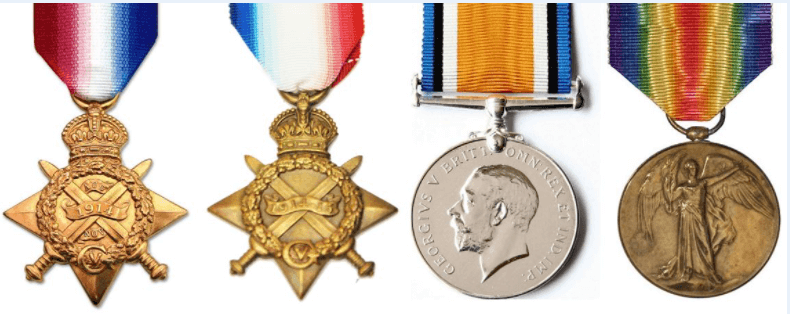
The Royal Navy
Officers are easily located in published lists and biographical dictionaries. These identify the ships on which they served. However, a rating who served before 1853 is difficult to trace unless you know the name of a ship on which he served. Census indexes, civil registration records or parish registers may assist. For example, the parish registers of ports (and the Fleet registers) include many sailors’ marriages and the man’s ship is sometimes recorded.
Officers might be commissioned officers (such as admirals, commodores, captains, lieutenants and commanders) or warrant officers, who headed specialised branches of a ship’s company (including the master, surgeon, boatswain, carpenter, gunner, purser and engineer). Many warrant officer ranks were upgraded in the 19th century to commissioned officer rank. You should commence research of officers in published sources.
You should then refer to the navy lists which were first published in 1782 and superseded in 1814 by the annual official Navy List. A few other official and unofficial lists of naval officers were also published between 1700 and 1782. Each Navy List contains lists of officers (either alphabetically or by seniority but usually indexed) and most of them provide cross references (for each officer) to separate entries for each ship, listing the names and ranks of the officers on that ship. The lists include all commissioned officers but also many warrant officers, such as surgeons, pursers and (in later lists) mates, boatswains, chief engineers and midshipmen.
Searching the Military Records
The best way to search these records is using the Advanced Search facility, you can access this by clicking the 'Search' tab along the top of the website and choose 'Find Records'. Scroll down the page for a list of databases, and choose the required record set from the ‘Military’ drop down menu.
Airforce Operations
These records not only cover this important fight for Britain's survival, but also encompass all of the Second World War period for a number of squadrons.
The Operation Record Books (ORB’s) are fully searchable by name, aircraft, location and many other fields, making it easy for researchers to find their aviation ancestors. The fascinating pages from these diary-like documents tell the stories of brave aircrew, including those at the time of the Battle of Britain. Recording patrols flown, the daily journal records give insights into the everyday lives of the personnel on bases. Researchers can use the collection to follow an airman's war time experiences which cover various Royal Air Force, dominion and Allied Air Force squadrons that came under British Command.
These records allow the family history researcher an interesting insight into relatives who had served in air force units under wartime conditions. They provide a summary of daily events - some are ordinary entries, such as the names of new pilots posted to the squadron, entertainment on the base, or even noting the fact that an officer has become engaged. Sadly, these ORBs also record the death of pilots, crashes, or names of airmen that were missing in action. As names of personnel are recorded in these reports, for a family history researcher wanting to follow where an ancestor was posted and what may have happened to them in the war, ORBs are often very enlightening documents.
Below is a report detailing Roald Dahl's dramatic entrance in his posting to No. 80 Squadron in 1940:
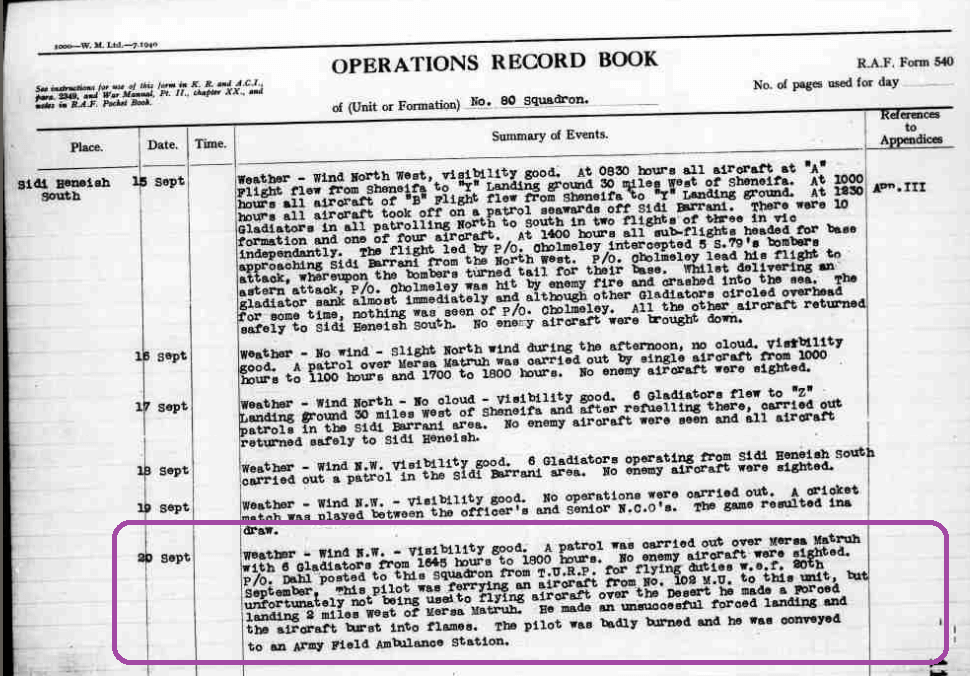
Use these records to:
- Read the war movements of personnel in air force units
- Discover if a pilot, navigator, radio operator or gunner is mentioned in the action
- Find if an airman is listed for receiving an Honour or an Award
- Add colour to an aircrewman's story
- Note the names of squadron members wounded, killed, or did not return
- Easily search these National Archives records and images
The best way to search these records is using the Advanced Search facility, you can access this by clicking the 'Search' tab along the top of the website and choose 'Find Records'. Scroll down the page for a list of databases, and choose 'Air Force Operations’’ from the ‘Military’ drop down menu:
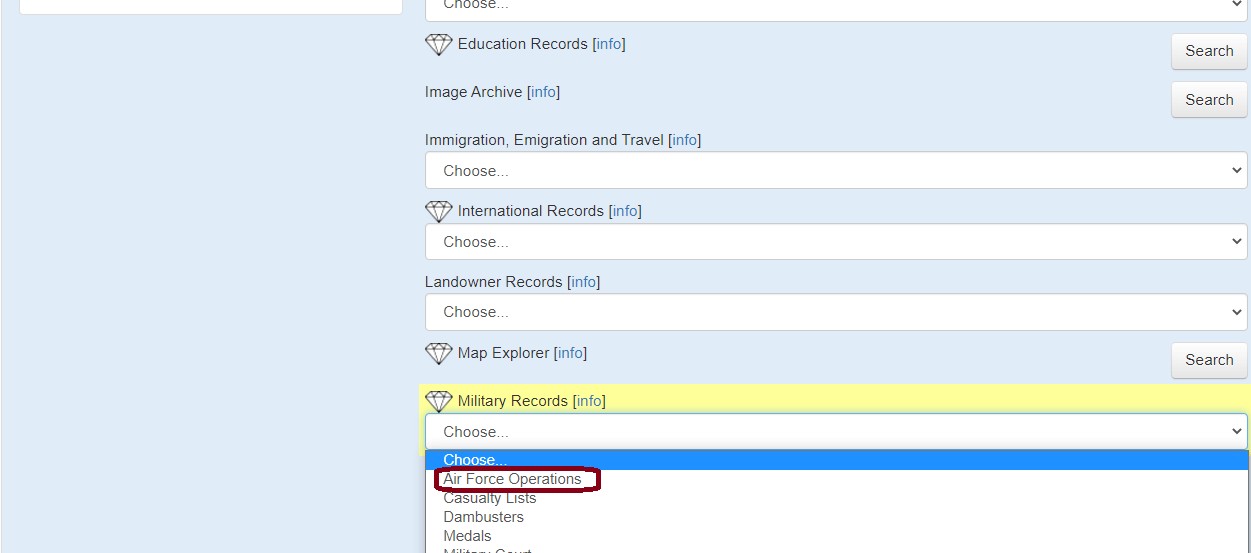
Casualty Lists
According to War Office statistics, the First World War claimed the lives of over 700,000 British soldiers. 170,000 were captured as prisoners of war and a staggering 1.6 million soldiers were injured.
The Casualty Lists on TheGenealogist offer the family historian a full history of those servicemen who were wounded in the First World War. For details of all wounded British and Commonwealth troops this is a complete resource now available online. From famous war poets to the brave soldiers in the 'Pals' Battalions, the shocking numbers of wounded servicemen are listed in complete, accurate detail. The records published illustrate the number of soldiers, sailors and airmen wounded. Many servicemen received wounds of varying degrees, for some it was the end of their war, for others they were back in action within days. Using the Casualty Lists you can see if and when your ancestors were wounded in the line of duty.
You can search these via the Advanced search page, please select Casualty Lists from the Military drop down menu, here you can enter the Forename, Surname, Status, Regiment, Service Number etc.

Often the first names on these records are recorded as initial only so you may want to leave the forename field empty if you are unable to locate the entry using the full forename.
Second World War Casualty Lists sourced from collection WO 417 held at The National Archives, contain records from the war years of 1939 to 1945 and list casualties sustained by the British Army during the Second World War. There are volumes for Officers and Nurses, with separate volumes for Other Ranks. The Casualty Lists were compiled from daily lists that had been prepared by the War Office Casualty Section and cover the various expeditionary forces deployed in different locations across Europe, Africa and Asia as well as for personnel at home.
WW2 Casualty Records will give family history researchers details of ancestors' names and regiments as well as ranks and service numbers for those recorded. The World War 2 casualty lists contain more detail than their WW1 counterparts and often list the date of the casualty (as well as the list date), plus other information such as the unit a soldier had been serving in at the time.
Included in these lists are those who had been unaccounted for by the military, were dangerously ill or injured, were captured as a Prisoner of War or died. The records include troops who had been serving in a number of places across the world, but also cover personnel who had lost their lives, were injured at home or were serving at an overseas station outside the theatres of war. Updates and corrections appear in the records as new information was received by the War Office.
Dambusters
Full online access to records for one of the most daring bomber raids of World War Two - the Operations Record Book of 617 Squadron.
During the successful operation in the summer of 1943, two dams were breached and one was damaged, severely impacting German resources. However this success came at a high price. Of the 19 Lancaster Bombers that took part in the operation, 8 were shot down, with 53 aircrew killed and 3 taken prisoner.
With these records added it is now possible to look at every airman involved in the raid, including all the brave aircrews and how they fared in this unique bombing raid. Find them under 'Dambusters Crew'.
Military Courts
Home and Overseas General Court Martial records covering the years from 1879 to 1927. These records take into account the hundreds of First World War British and Commonwealth soldiers that were executed for cowardice and desertion.
In the records we find Private Thomas James Highgate who was the first British soldier to be shot for deserting his unit in the retreat from Mons in 1914. Military justice at the time saw the defendants receive a hasty and one-sided trial in line with emergency wartime military procedures. Death sentences had to be agreed by the Commander-in-Chief who was expected to take the current military situation into account. With the British Army in retreat after the first battle at Mons, senior officers made a decision to stamp out any thoughts of desertion and Private Highgate suffered the highest punishment.
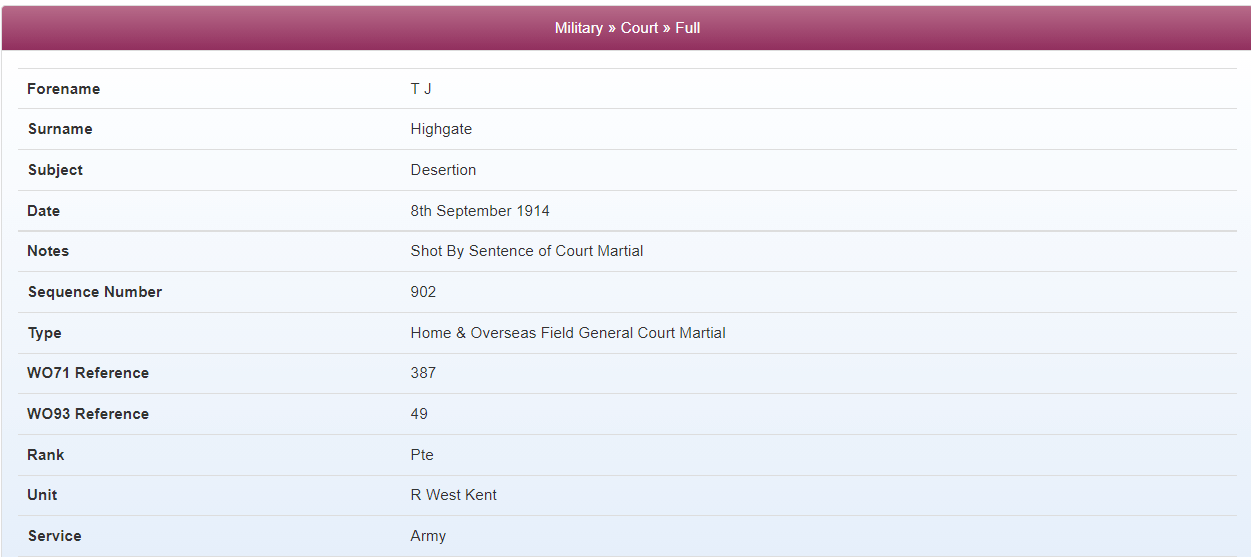
A mass pardon of 306 British Empire soldiers executed for certain offences during The First World War received Royal Assent on 8 November 2006.
Included in this record set:
Royal Navy, Royal Marines, and the Naval Reserve and Auxiliary Forces Courts Martial Proceedings, 1911-1965
Royal Air Force Courts Martial Proceedings, 1941-1994
British Army Courts Martial Proceedings, 1879-1986.
Soldiers Executed, 1914-1920
Military Rolls & Lists
Army, Navy & Air Force Lists
We currently have Army Lists available ranging from 1661 to 1940 and Navy Lists ranging from 1689 to 1944. Army Lists can contain rank and regiment of officers, details of those stationed abroad and recipients of the Victoria Cross.
We have also added Air Force Lists for 1918, 1921,1933, 1936,1937,1938, 1939, 1940 and 1944. These list all officers and various sections of the RAF. The book is searchable and bookmarked by major headings. The 1939 List includes Viscount Trenchard, the ‘founding father’ of the RAF and Guy Gibson, who led the “Dam Busters” across Germany in 1943.
In addition we provide access to the US Air Force Register Vol 1 Active Lists 1959 and US Air Force Register Vol 2 Retired Lists 1959.
You can see a full content list here http://www.thegenealogist.co.uk/coverage/military-records/?level=diamond#includes
Images can be browsed with the aid of bookmarks or searched using our OCR software, which turns the pages into searchable text, allowing you to enter a name and bring back all the pages with matching results:
After selecting ‘Military Rolls and Lists’ from the Advanced Search page, you'll then be asked to select a record set. You will have the option to choose Militia Lists and Indian Army as well as Army or Navy Lists. You'll then be taken to the page where you can select a year range of books.
Muster Books and Pay Lists
The earliest records in this dataset are 16th century Militia Musters for Somerset. The Certificate of Musters in the County of Somerset 1569 contain names of Militiamen (soldiers raised from the civil population) and what role they carried out including archer, pikeman and light-horseman
The Militia Act of 1757 provided for men at home to serve in a militia in order to counter any threat, while the majority of the regular army was stationed abroad. Lists of eligible men in each parish were known as militia ballot lists and from these, the men actually chosen appeared in the militia lists.
Unfortunately only records for 1781-82 survive. These muster and pay lists provide details for the men in the regiments. County regiments, although recruited locally, often served away from home and these indexes tell precisely where, under whom and on what dates the men were mustered.
Many thousands of men of the British Army were serving overseas in far flung parts of the British Empire over the 1800s. This index of names is compiled from the Musters contained in WO 10-11-12 Series War Office Paylists held at the National Archives, Kew. The 1851, 1861 and 1871 Worldwide Army List lists all officers and other ranks serving in the first quarter of 1851, second quarter of 1861 and 1871 together with their regimental HQ location (Although the 1861 index excludes officers as they were not mustered in all the Paylists). The index is, therefore, effectively a military surrogate for the census.
Over 70,000 records have extra notes that can indicate whether a soldier was discharged, on leave (along with their location), transferred, or retired. Many notes include a place of birth and former occupation.
Also included within the records are recruits, boy soldiers, bandsmen and civilians working in the armed forces as clerks, pension recruiters and suchlike. Colonial regiments, which invariably contained numbers of British subjects are also featured.
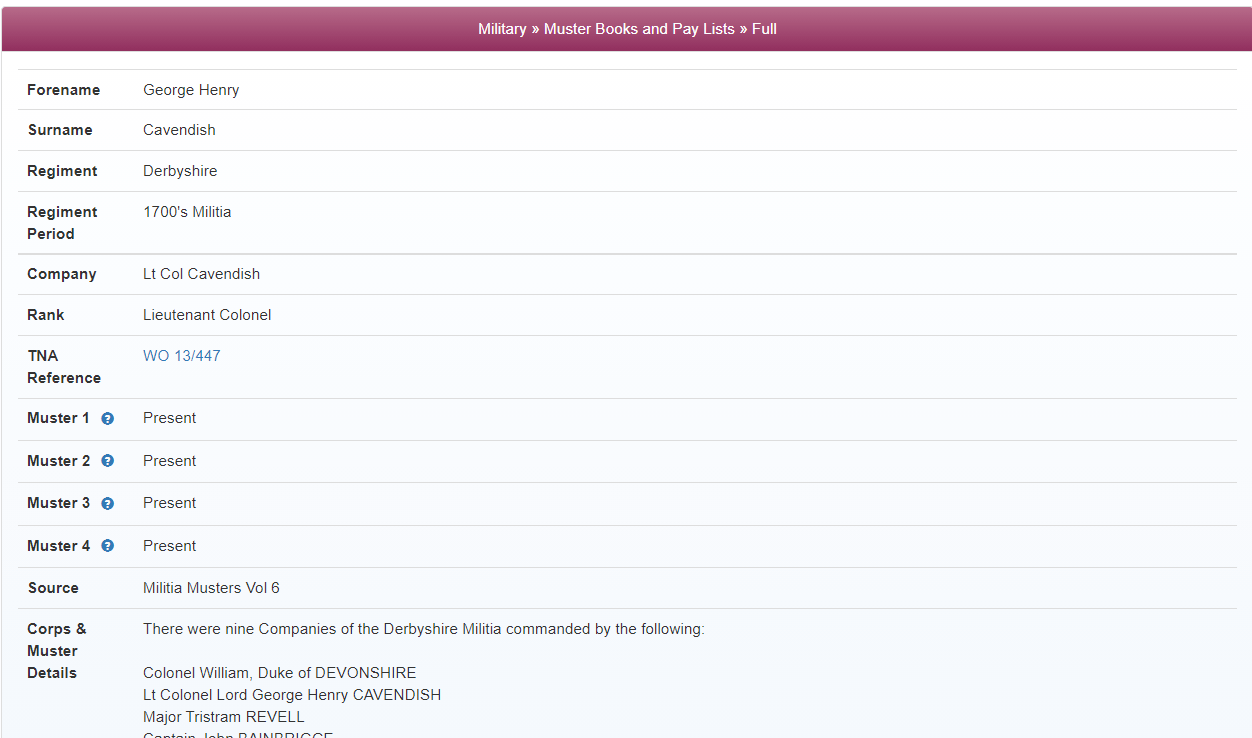
Above George Henry Cavendish, a well-known ‘militia man’ of the time.- a Whig politician who was nominated as a Colonel in the Derbyshire Militia in 1783.
Newspapers
Illustrated War News & Illustrated London News - These newspapers covering the First World War combine photography with the use of graphical illustrations from eye witness reports to give readers a flavour of what was happening at the front.
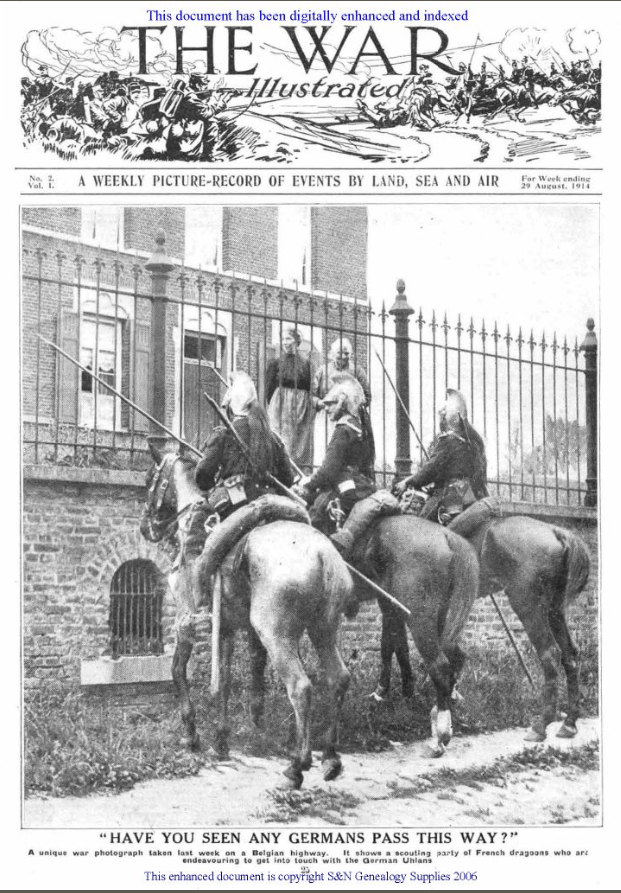
Wipers Times - This newspaper contained the more truthful and realistic views of the frontline troop that were subversively published at the time by the troops themselves. The paper consisted of poems, reflections, army in-jokes and lampoons of the military situation the Division was in at the time.

The Navy and Army Illustrated which covers over 280 issues from 1895 to 1901 giving approximately 6,700 pages of lavishly illustrated information on all aspects of news relating to the fighting forces of Britain and its Empire
The Somme Times - 31/07/1916 edition
The Great War - 1914 to 1919 editions
Overseas BMD’s
The General Register Office's Army, Marine, Air Force, High Commission, Regimental, Consular and Ionian Islands BMDs.
The records show name, regiment, vessel, station, location or consulate along with volume and page number (where given).
These BMD records can help you trace your ancestors who served in the forces. They are provided with greyscale and black and white images of the original GRO microfiches.
The set includes:
Marine Births 1837-1915
Army Births & Registers, Marriages and Deaths 1747-1980
Consular Birth, Marriages, Deaths 1849-1915
Informal Certificates of Birth at Sea 1839 - 1867
Ionian Island Births, Marriages, Deaths 1818 - 1864
Regimental Births: 1407 - 1997
The General Register Office's Marine Registers record deaths at sea on ships registered in Great Britain or Ireland from 1 July 1837
POW Records
TheGenealogist has fully searchable records of British and Commonwealth prisoners, of all ranks, captured in the Great War. Many thousands of Allied servicemen were taken prisoner in the First World War and comprehensive records have been notoriously difficult to find with many related records being destroyed in the 1930s and the World War 2 Blitz of 1940. The records provide access to records of all servicemen taken prisoner between 1914 to 1918.
Below you can see a famous inmate at the Holzminden Camp, the future Hollywood Director James Whale a second Lieutenant in the Worcestershire Regiment who went on to direct the film Frankenstein:
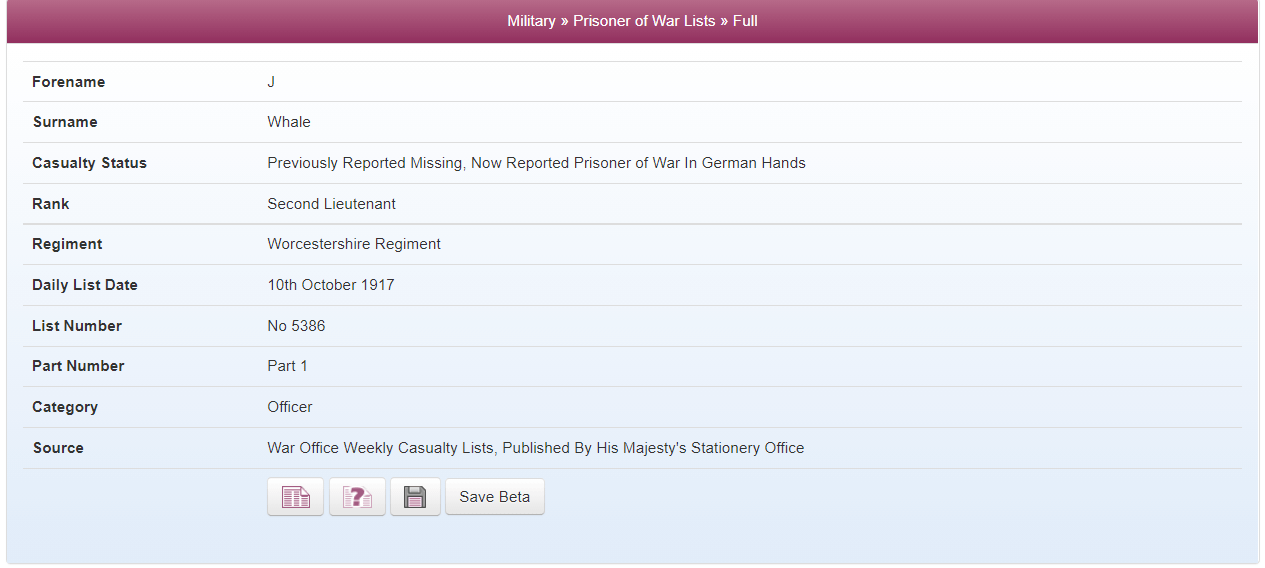

Search all Ranks from The Great War.
From senior Officers Captured, to the NCOs and Privates in the Infantry, the records are all found in the ‘Prisoner of War’ collection on TheGenealogist, giving access to the many soldiers, sailors and airmen captured and held behind enemy lines.
The records are fully searchable and provide the main details including Forename, Surname, Rank, Regiment and the date the information was received.
TheGenealogist also provides access to World War II Prisoner of War records. These records detail Officers and other ranks from the British Army, Royal Navy, RAF and those members of the British Empire land forces that were held as Prisoners of War in Germany and German Occupied territories.
This record set allows researchers to discover servicemen held by the Germans between 1939-1945 and includes many of the brave escapees whose stories of breaking out and dashing to freedom have captured the imagination for decades.
These records allow us to:
- Research POWs who served in Armies and other land forces of Britain and the Empire 1939-45 along with the Naval and Air Forces of Great Britain and the Empire 1939-1945
- Find names and details of men who were captured and incarcerated in German POW camps in Europe
- Check the details such as names, service numbers, and regiments of ancestors that were German POWs
- Search for daring escapees from within the camp lists
- Research where your military ancestors were held, revealing their camp number and location
- Discover the ranks, POW numbers, Service numbers and Regiments of those held
Covering the Nazi German camps in Europe, these lists are taken from official alphabetical nominal registers and reveal names and other particulars of:
- 94,608 British POWs in Germany, including Officers and other ranks
- 39,805 POWs from Empire Land Forces
- 19,250 Naval & Air Force POWs from Britain & its Empire
Regimental Records and Histories
These publications often provide details of battles and campaigns that the regiments were involved in and also lists the officers, and in some cases the men. They typically include various details relating to honours and medals awarded in the conflict. These military histories concentrate on a particular regiment, battalion or division and typically give a good account of the men’s progress across the battlefield usually including maps for better understanding the geography.
Most of these narratives will also name men and officers who had distinguished themselves on the battlefield and so if your soldier ancestor had been involved in some action at the time, that deserved a mention, then these records could fill in the story of their war for you.
The histories are compiled from the diaries and papers of the regiment and so the reader can follow its progress through the theatre of war.

Roll of Honour
Many family historians go straight for the usual military records when searching for war service details, but there are other great sources of information that can provide you with details of what your ancestors did in the war.
Many skilled professionals were a part of membership organisations, professional bodies and unions. These organisations all kept records of their members. As World War I had such a high casualty rate and young professionals were often at the forefront of the struggle, the membership records have become a lasting tribute to these brave men.
Roll of Honour (Books)
These can be found under Military -> Military Rolls & Lists -> Rolls of Honour
Soldiers who died in the First World War
These records were published in June 1921 by authority of the War Office and provided 80 volumes containing the names and details of the soldiers who had died during active service in the war. These volumes, divided regimentally, list over 650,000 of the 'other ranks', and can provide details such as the places of birth and enlistment, rank and regiment, and the cause, place and date of death.
Transcription of the poet Wilfred Owen who lost his life in conflict just 7 days before the war ended:

War Memorials
Memorials were erected by the Imperial War Graves Commission to record the names of the officers and men who fell in the Great War and whose graves are not known. This database contains the names of men recorded on memorials. Entries include regiment and number, date of death and can contain personal details such as the town they were from and parents names. Includes a map of the area with descriptions of the battles that took place.
Choose ‘War Memorial Lists’ from the’ Military’ drop down menu on the Advanced Search Page to search.
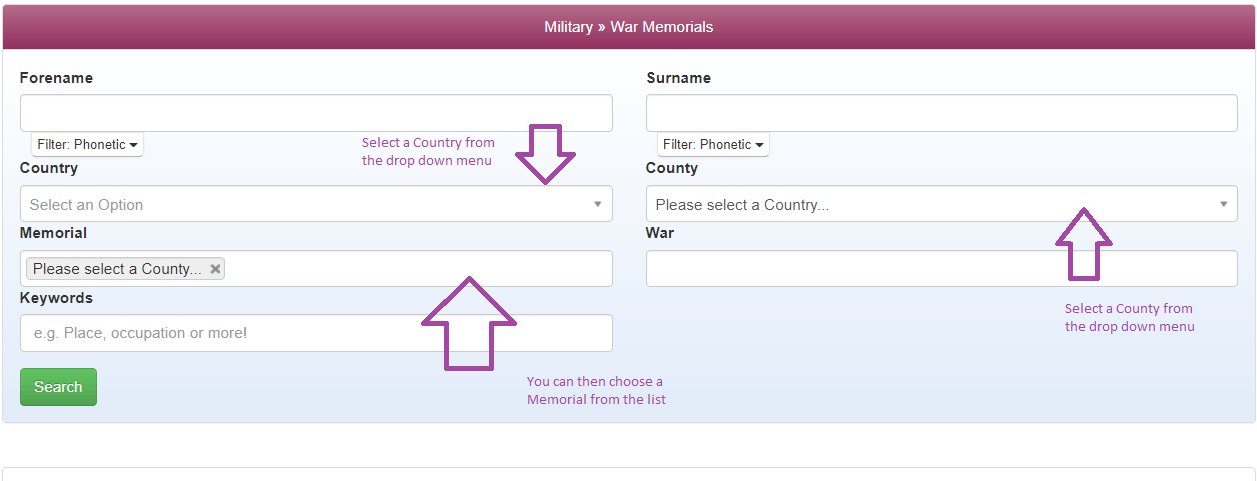
Waterloo Roll Call
You can search The Waterloo Roll Call of 1815 using Title, Forename, Surname, Regiment, Rank, and other fields where given. This list is of mainly officers who were present at the Battle of Waterloo in Belgium on June 18th 1815. They fought under the Duke of Wellington, whose record we can find in this collection.
The best way to search these records is using the Advanced Search facility, you can access this by clicking the 'Search' tab along the top of the website and choose 'Find Records'. Scroll down the page for a list of databases, and choose 'Waterloo Roll Call’ from the ‘Military’ drop down menu:
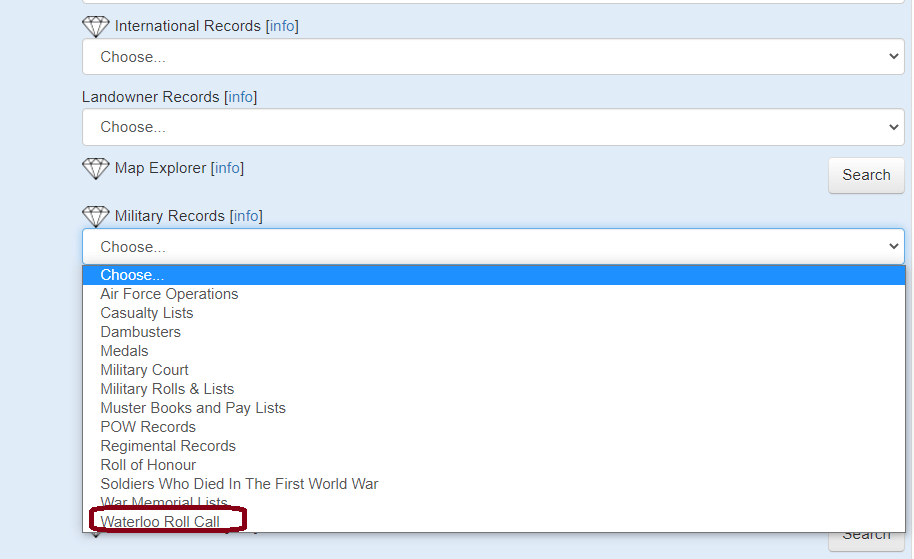
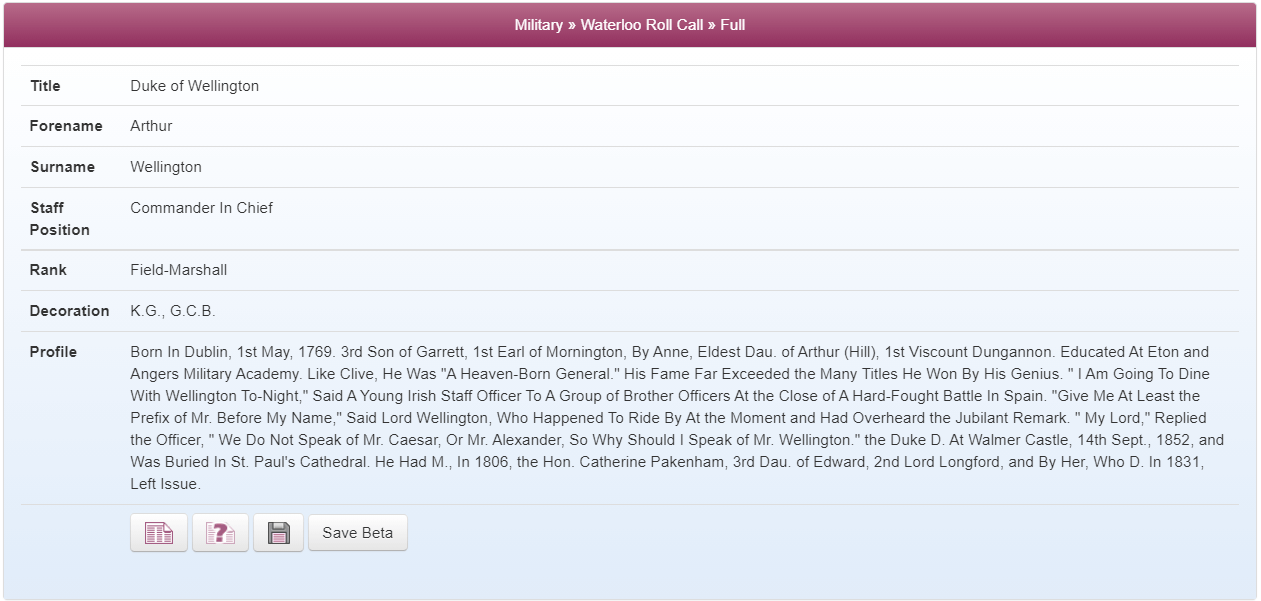
World War 1 Deaths and World War 2 Deaths
The World War I Death Index, provides an official GRO index reference as per the standard BMD Index, and you can obtain an Overseas Death certificate at www.gro.gov.uk.
We also provide a World War II Death index, both of which can be accessed from the Advanced Search page under "Birth Marriage and Deaths Menu’". Both World War indexes are in the same format as the Overseas BMD indexes (see section on using Military Overseas Indexes).

Non-Conformist Records
Nonconformist records are similar to parish records but derived from a nonconformist church or chapel. Nonconformist churches do not conform to the doctrines of the Church of England. In other words, these Protestant churches dissent from the established church. These groups include Presbyterians, Congregationalists, Baptists, Quakers, Methodists, Catholics and Unitarians.
Registers which were not those of a Church of England parish were called 'non-parochial' and by the Non-Parochial Registers Act 1840 the registers that had been received were deposited with the Registrar General and divided into 'authenticated' and 'unauthenticated' registers.
Non-Parochial Records are early registrations of Births, Marriages and Deaths from various sources.They include the Birth records from Dr Williams library in London, Hospital records of Maternity, overseas registrations for British Citizens and those on board ships.
Birth record of Florence Nightingale from the RG5 record set:
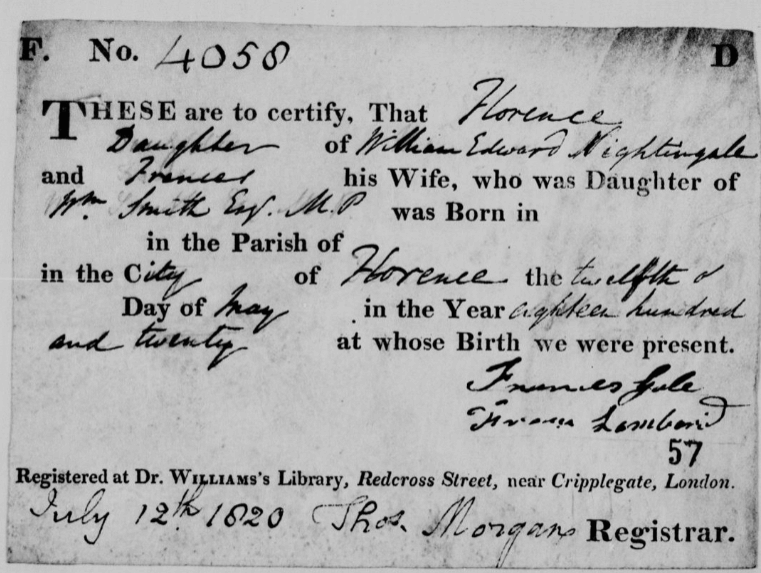
The record set includes:
- RG4 – Early Registers (authenticated by the Non-Parochial Registers Commissioners) of births, baptisms, deaths, burials and marriages. They cover dates from 1567 to 1858.
- RG5 – Early Birth Certificates from the Presbyterian, Independent and Baptist Registry and from the Wesleyan Methodist Metropolitan Registry. They cover dates from 1742 to 1840.
- RG6 - The Society of Friends' (Quakers) Registers, Notes and Certificates of Births, Marriages and Burials ranging from 1578-1841.
- RG7 – Fleet Marriages. The collection of registers and notebooks of Clandestine Marriages and Baptisms in the Fleet Prison, King's Bench Prison, the Mint and the May Fair Chapel ranging from 1667-c1777.
- RG8 – Early GRO Registers of Births, Marriages and Deaths surrendered to the Non Parochial Registers Commission of 1857. Among the more extensive collections in this series are the registers of the British Lying-in Hospital, Holborn, which record particulars of births and baptisms. These cover the period 1749 to 1868 and are very detailed. Burial records, registers of the Chapels Royal and the archive of the Russian Orthodox Church in London.
- RG32: Registers Abroad and on British & Foreign Ships 1831-1969General Register Office:Overseas Births, Baptisms, Marriages, Deaths and Burials Abroad and on British & Foreign ships, of British subjects, nationals of the colonies, the Commonwealth and countries under British jurisdiction. Also Lundy Island Devon and Channel Island records. Events affecting some foreign nationals are also included. Records consist mainly of certificates issued by foreign registration authorities, which are in local languages, and copies of entries kept by incumbents of English churches and missions, chaplains and burial authorities. These cover the period 1831 to 1969 and are very detailed.
- RG33 - GRO:Overseas Birth, Marriage, death and Burial of British Subjects including those onboard ships. Also Lundy Island Devon. Original registers, notebooks and copies of entries in registers kept by incumbents of English churches and missions, British embassies and legations etc. These cover the period 1627 to 1960 and are very detailed.
- RG34 - General Register Office: Worldwide Foreign Marriage Returns. More than 38,000 individuals are recorded in the overseas marriages records which include British subjects marrying abroad. These newly added records were previously only viewable on microfilm at The National Archives as the RG 34 series. Many of the marriage certificates were issued by the authorities in the country concerned in the local language. These have been translated to provide a searchable database and links to a digital image of the original record.
Included in this series you can find:
- Marriage registers of British churches abroad.
- There is also a collection of marriages between British soldiers in France, Flanders and Holland during and after the First World War, including many who had been prisoners of war.
The sources of these records covering British Citizens are worldwide and include marriage certificates issued by foreign registration authorities and churches, copies of entries in the registers kept by British embassies, incumbents of English churches and chaplains, notification of marriages of servicemen during service abroad, and documents deposited for safekeeping. These cover the period 1861 to 1921.
- RG36 Registers and Returns of Births, Marriages and Deaths in the Protectorates etc of Africa and Asia Covering dates 1895-1965. Notifications of birth, marriage and death forwarded by officials responsible for civil registration under administrative ordinances in Nyasaland, Kenya, Somaliland, Uganda, Sudan, Palestine, Sarawak, Malaya, including Johore and Selangor, and British North Borneo.
- BT158 Registry of Shipping and Seamen: Registers of Births, Deaths and Marriages of Passengers at Sea. Covering dates 1854-1908.
- BT159 Registry of Shipping and Seamen: Registers of Deaths at Sea of British Nationals. Covering dates 1875-1888
- BT160 Registry of Shipping and Seamen: Registers of Births at Sea of British Nationals. Covering dates 1875-1891
Occupational Records
Occupational Records can provide a greater insight into the lives of your ancestors. They can be used to complement census records, and as some contain address details and pre-date 1841 they are a valuable substitute for the pre-census years.
Records are book images (Printed Books), with search tools that enable you to enter a name and view results within the records, or browse through the images with the aid of bookmarks.
Includes the occupations listed below with years ranging from 1066 to 1935.
- Actors & Playwrights
A biographical record of actors, playwrights and their works. Information includes background history and a record of their individual works.
- Apprenticeship Records
The records give the name, addresses and trades of the masters, and the names of the apprentices, along with the sum the master received for the apprenticeship. Until 1752, it was also common to see the names of the apprentices’ parents on the record.
We have expanded our occupational records with over 300,000 records of Masters and Apprentices included in a nautical set of apprenticeship records. These BT 150 records from The National Archives comprise of an index that had been compiled by the Registrar General of Shipping and Seamen and its predecessor. It consists of apprentices indentured in the Merchant Navy between 1824-1910.
The books have now been transcribed and include colour images of the original registers to add a fascinating resource to their broad range of records which can be used to build an ancestor's story
Example Image below shows Apprentice name, Masters name, Year of Indenture and Masters Trade.

- Biography and Who’s Who
Biographical records are a valuable resource for family historians, as they provide detailed information on individuals, which can include birth, marriage and death as well as achievements, education and where they lived. Some entries also provide information on other family members such as parents and siblings.
- Catholic Miscellaneous
Access to Biographical dictionaries which form the collective authority for Catholic Biographical history of English Catholics in addition to Catholic Record Society volumes and more.
- Clergy Lists
Biographical details of Directory of ordained clergy of the Church of England, the Church in Wales, the Scottish Episcopal Church and the Church of Ireland and many more.
- Directors Lists
A list of the directors of the principal joint stock companies whose securities are known to the stock markets of the United kingdom.
- Freeman and Burgesses Books
Freemen were individuals who had earned privileges and the right to work in the cities, these books contain names and occupations of the Freemen.
Lists of burgesses in the borough and prominent town members these books contain names, addresses and the nature of their property held.

- Insolvants & Bankrupts
List of Bankrupts with Their Dividends
- Jewish Records
Those with Jewish ancestors from London will welcome this fascinating record set which reveals details of positions held by forebears. Track ancestors who became wardens, council members, or served on committees of their synagogue, as well as seatholders in synagogues from around the capital city. These fully indexed records allow family historians to search by name, keyword, synagogue and address and with one click see an image taken from the pages of Seatholders for Synagogues in London.
Use in conjunction with the Jewish Chronicle Newspaper which contains Births, Bar Mitzvahs, Betrothals, announcements, Marriages, Deaths, Obituaries, Wills and much more.
- Law Lists
Lists of certified attorneys, notaries, Biographical dictionary of Judges of England and Justices of the peace for England and Wales
- Medical Lists
Records covering Doctors, Midwives and Opticians can be searched by name and keywords.Use these records to:
- Add details to the lives of your medical ancestors
- Discover Doctors etc. who served in India in The Madras Medical Register 1934
- Find Medical Ancestors in The Medical Who's Who 1912
- Seek out midwives in The Midwives Roll 1905
- See optometrists names in the Institute of Ophthalmic Opticians, Official Directory, 1927
In the image below we can see Miss (later Dame) Mary Rosalind Paget (4 January 1855 – 19 August 1948). A prominent nurse, midwife and reformer she played an active role in the campaign for midwife registration

- Merchant Navy Apprenticeship Records
See Apprenticeship Records above
- Occupation Dictionary
Dictionary of Occupations - enter an occupation in the search field to obtain a definition
- Pilot Certificates
Royal Aero Club - Aviators Certificates (1914-1926)
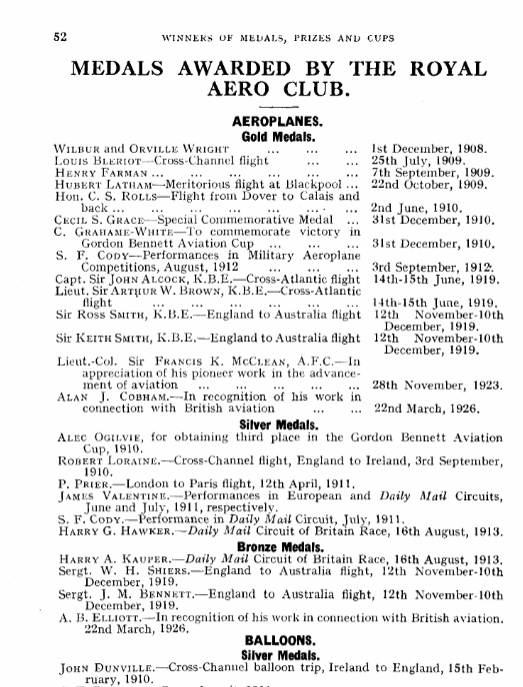
- Police Letter Book
This is an intriguing mixture of promotions, retirements, movements, and other observations about Police officers in this county from 1891 to 1911. Amongst its pages, you will be able to trace the career of your Hampshire police ancestors as they rise, or even fall.
These records reveal names and collar numbers of officers promoted, reduced in rank or dismissed from the force for committing various acts of misconduct. The misdemeanors often seem to involve alcohol, ranging from accepting a glass of beer to being drunk on duty. For those more competent officers, who were commended for their actions in the pages of these documents, you can read the actions that had been seen as deserving of inclusion in the Letter Books.
Below is an excerpt from 1899 relating to a Royal Visit at Romsey Police Station:
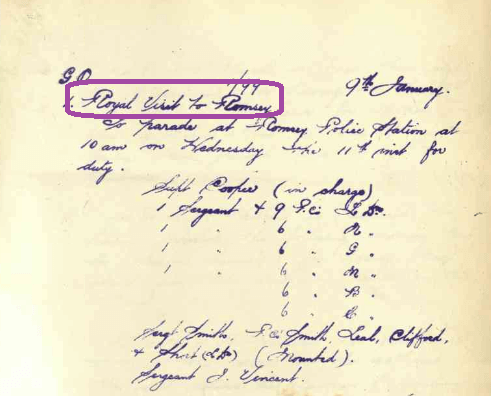
- Railway Employment Records
The collection contains records from a number of different sources and various record sets, with exact details on their job role and their date of birth. From station master to train guard, they’re all listed in the Railway records.
We have added Cornish Railwaymen which list the names of all the men employed by the Cornwall Railway at the time of its take-over by the Great Western Railway Company on 15 June 1889.
Information includes (where available) names, occupations, places of work, wages or salaries, dates of entering service, and dates of birth for the officers and clerks.
- Find details of railway ancestors, where they were employed and what they did
- Trace your railway worker ancestor’s careers through their promotions
- Discover when they retired
- Read obituaries
The Railway Company Staff magazines are useful to family historians with railway employee ancestors, wanting to find important occupation related dates and add some social history to their family tree. These records include such details as staff changes, promotions, pension records, retirements and obituaries. Often additional personal information is revealed in the magazines. In some cases you can read about gifts from co-workers given when rail staff leave.
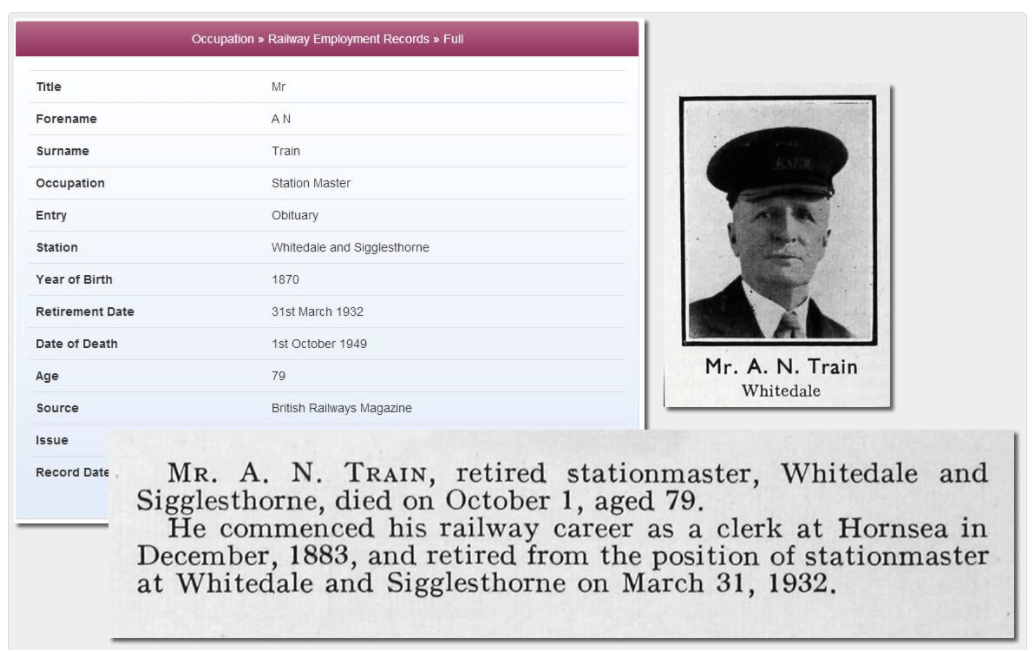
- Ship Crew Lists
1851 - These lists and agreements are intended to find many of those involved in merchant shipping who cannot be located on the 1851 census because they simply were not at home to be enumerated. Some were at ports in the British Isles many miles from home and some were not even in the country. Details given include age, place of birth, rank and ticket number, previous and current ships with ports of registration, dates and places of joining and leaving, reason for leaving.
- Sports People
As TheGenealogist.co.uk includes the occupation field in their census transcripts, you can easily find out if your ancestors participated in sports with many entries recorded with sporting professions. The keyword search facility allows you to search without a name so you could search purely on occupation. A search across the 1911 census for example for an individual sport such as footballer, cricketer, jockey, professional boxer or a more general 'athlete' can reveal the sporting heroes of the time.
The extensive occupational collection on TheGenealogist also provides post-census sporting records with the '1935 Who's Who in Sport'. This biographical book contains listings of sporting individuals including achievements in their specialist fields, and provides an encyclopedia of sports and games, sports obituaries, and sporting bodies.
'The Great War' available in the Newspaper collection, focuses on fallen sportsmen in the Roll of Honour sections, with tributes to athletes such as Wyndham Halswelle who was killed at the Battle of Neuve Chapelle in 1915.
School, College and University records are another great resource for sporting ancestors with leading institutions such as Oxford and Cambridge producing many of our past sporting heroes. Albert Gladstone, the grandson of former Prime Minister William Gladstone, competed in the 1908 London Olympics and won a Gold medal in rowing. He is shown on the 1899 - 1909 Eton School Register on TheGenealogist.
- Teachers Lists
Official list of registered Teachers records
Full coverage can be viewed at:
https://www.thegenealogist.co.uk/coverage/occupational-records/?type=diamond#includes
Parish Records
Before the introduction of Civil Registration in 1837, the only records to the key events in people's lives were recorded in the registers of parish churches and some non-conformist places of worship.
In 1538 Thomas Cromwell, the Vicar General to King Henry VIII, declared that all marriages, baptisms and burials should be recorded; normally these are kept at the Parish Church, and are known as 'Parish Records'. In 1598 an Act was also passed that meant these records should be copied and sent to the bishop, these are known as Bishop's Transcripts.
Although most parish registers usually date to around the mid-16th Century, when Elizabeth I declared that accurate registers should be maintained, some are also available from 1538. Elizabeth I had instructed that they should be preserved in bound books and not on any old scrap of writing material. Even after her efforts, many registers have been lost over the years and those surviving today are now usually safely deposited in the local record office, not the church they are associated with.
Parish registers can contain large gaps, such as for the Commonwealth period, which can leave the mid-1600s looking sparse. You also get volumes which have gone missing over the years leaving frustratingly large gaps. Small gaps are not as bad unless they happen to coincide with the event you are looking for. These are usually due to negligence, often occurring where the clerk didn't enter them at the time and forgot to do it later. If you are lucky, some of the larger gaps in Parish Records caused by lost volumes may be covered by the Bishop's or Archdeacon's Transcripts. These are copies of the events copied from the Parish registers which were sent to the Diocese each year. BT's may themselves be incomplete, especially at the beginning or end of the periods.
Unlike the Census or the Civil registration material, Parish Records are scattered all across the country, so it will be well into the future, if ever, that we will be able to search them online in the same way. Most churches have deposited records over 100 years old at their local record office, but some still retain burial registers for example, that were started in the last century and still are not full yet. Chapel records are not as well preserved, some are in private hands and many have been lost. However, there are many parish register transcripts published by various parish record societies, historical groups and individuals and these lend themselves to being made accessible online.
Most people are tracing a surname line, but the tradition of marrying in the bride's parish can make marriages before 1837 difficult to trace. When a man marries out of the parish there are often no clues as to where he went, thus requiring extensive searching of an ever widening circle of surrounding parishes in the hope of finding him.
You may strike it lucky if they were married by Banns and the Banns register still exists, though not many do. Early genealogists, for whom record access was more difficult than today, recognised the difficulties of tracing marriages and this led to several of them creating manuscript indexes. The best known are Boyd's and Pallot's, however Phillimore set about it in a different way, transcribing and publishing marriages from many churches. The parish records currently available on TheGenealogist are taken from various published transcripts, and include many from the Phillimore series of transcripts of marriage registers.
Searching Parish Register Transcripts
The Genealogist has now put online thousands of parishes. These have two main formats, database (Transcripts) and searchable book images (Printed Books). Both the transcripts and books are searchable from the Master Search the transcribed Parish Records will come up under Births & Baptisms, Marriages or Deaths and Burials and the Books are listed under Parish Record Books:
You can see a full content list of all the parishes we currently have available here http://www.thegenealogist.co.uk/coverage/parish-records/?level=diamond#includes
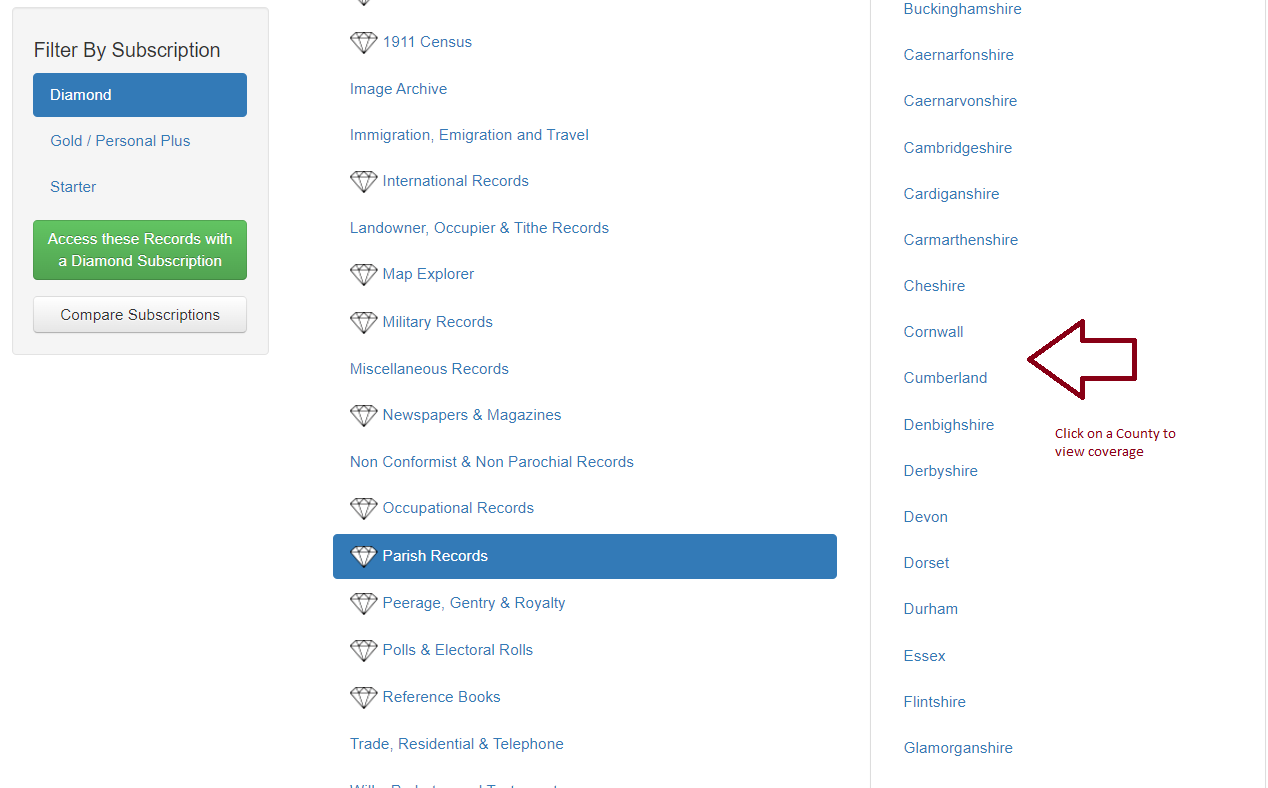
The database records consist of easily searched transcripts of the original records which allow you to search them on various fields and may also have linked images of the original registers. This feature depends on the local archive giving permission to publish the images.
When searching from that Master Search you can filter your results to show just Parish record results by selecting this option from the options down the left hand side of the page.

You can also search Parish Record Transcripts from the Advanced Search page, you can access this by clicking the ‘Search’ tab along the top of the website, choose 'Find Records' from the drop down menu and scroll down the list to select Parish Records (Transcripts) from the list of databases. You will need to select the county which you wish to search from the drop down menu:

Searching Parish Register Printed Books
Step 1 - Select 'Parish Records' from the list of databases:
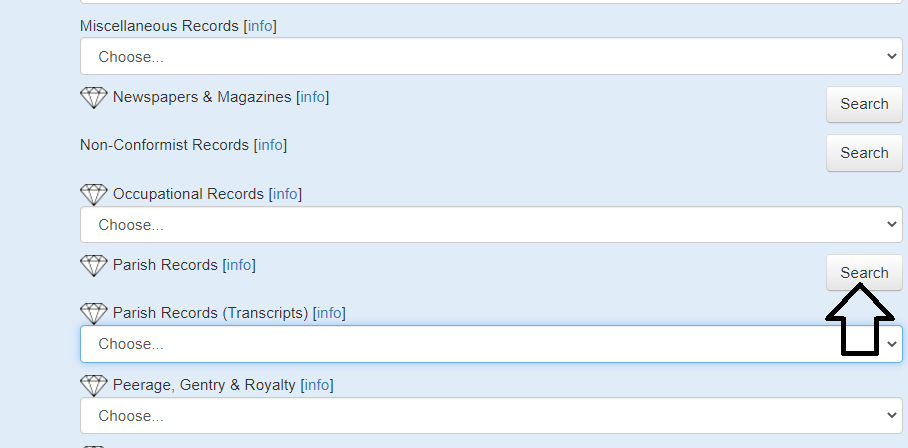
You'll then be taken to the first part of the search interface, where you can select which county you wish to search.

After selecting a county, a list of available parishes will be displayed:

Step 2 - Click on your preferred parish to open up the image viewer window, which will immediately locate the parish on the bookmarks and take you straight to the relevant page. You can then browse the book page by page or you can search using the boxes provided, a unique feature on TheGenealogist to help you save time locating your ancestors. Searching Printed Books can often be time consuming on other sites, but with our interface you'll get accurate results faster. The books are still easily browsed page by page, either using the bookmarks or the navigation icons on the left.The search tool has also been integrated into the image viewer, to limit the amount of time spent changing between different windows.
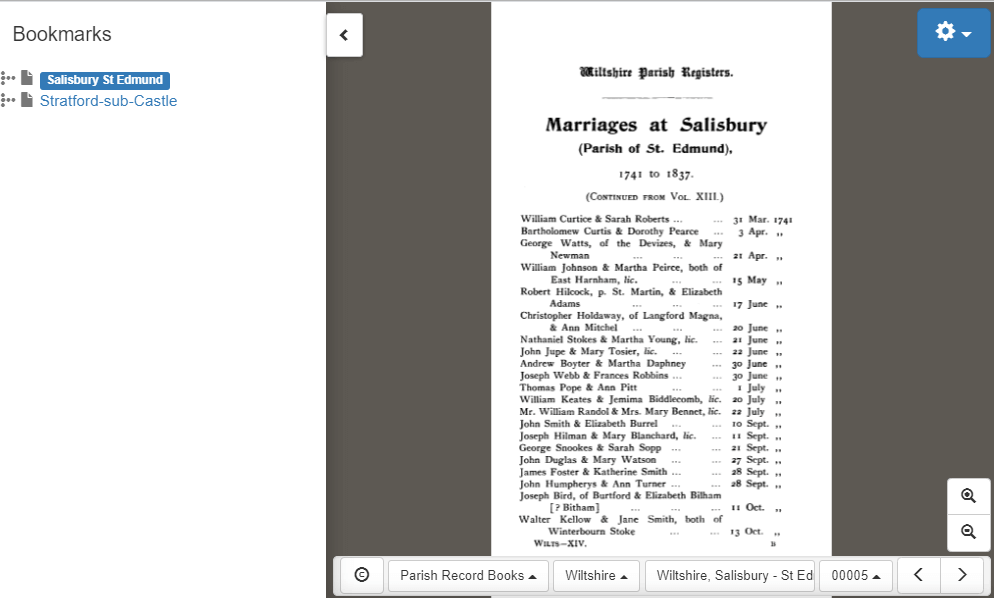
Step 3 - Enter a surname into the box provided, and a forename if preferred, and all instances of the name within the book will instantly be located and you can click to view each result from here:

Catholic Registers
The following Catholic Records, have been added to the Parish Registers Printed Book section of the website:
- Catholic Mission Registers:
- St Peter's, Winchester 1731-1826
- Cowdray, Easebourne and Midhurst 1745-1837
- Pethir 1758-1818
- Bellingham, Northumberland 1794-1837
- Catholic Registers of Cheam, Surrey 1755-1788
- Catholic Registers of Wootton Wawen, Warwickshire 1786-1843
- Catholic Registers of Holywell, Flintshire 1698-1829
- Catholic Registers of Nidd Hall, N.R. of York 1780-1823
- Catholic Registers of Llanarth, Monmouthshire 1781-1838
- Catholic Registers of St. Joseph's Chapel, Trenchard Street, Bristol 1777-1808
- Catholic Registers of Robert Hall and Hornby, Co. Lancaster 1757-1851
- The Catholic Registers of York Bar Convent Chapel 1771-1826
- Catholic Registers of Courtfield in the Parish of Welsh Bicknor, Monmouthshire 1773-1832
- Catholic Registers of Britwell-Prior, Oxfordshire 1765-1788
- Catholic Registers of Isleworth, Middlesex 1746-1835
- Catholic Registers of Newport, Shropshire 1785-1846
- Catholic Registers of Culcheth, Lancashire 1791-1825
- Catholic Registers of Southworth Hall, Lancashire 1795-1827
- Catholic Registers of Danby, West Witton and Leyburn, Yorkshire 1742-1880
- Registers of Fr. Thomas Worthington, Kept in Lancashire 1713-17
- Registers of the Rev. Pierce Parry at Claxby, Lincolnshire, and Oscott, Warwickshire 1755-1766
These are searchable by selecting ‘Catholic’ from within the list of counties.
Peerage, Gentry & Royalty
Peerage and Heritage records document the ancestry of titled and landed families in the United Kingdom and Ireland. Entries can contain details of individual peers providing biographical information such as births, marriages and names of family members.
These records are not only limited to researching upper class ancestors, as inter-class marriages occurred frequently, particularly with the younger children, and can provide useful information for many family history researchers.
“An enormous number of people, of all classes and financial status, are descended from noble families, particularly because the wealth and importance of families varied substantially over time. Younger sons of a family were often not as wealthy as their fathers. For example, the youngest son of a duke might join the army but not reach the rank of captain. His youngest son might have been a farmer. His son may have been a shopkeeper and his son only a labourer. Marriages also linked one class to another. Thus daughters of kings might marry nobles, daughters of nobles might marry knights, daughters of knights might marry local yeoman and so on. It is therefore possible to trace a family relationship that extends, within only a few generations, from the highest in the land to the lowest. In view of the number of ancestors that you have, it is possible that pedigrees of the nobility will be relevant to your family tree.”
- extract from Ancestral Trails by Mark Herber p.617-618
We currently have Peerage & Heritage records covering all of the UK ranging from 1664 to 1921, which include Burke’s, Kelly’s and Debrett’s Peerage records.
The records are from books (Printed Books), which the Master Search enables you to enter a name and view results within the books, or browse through the images with the aid of bookmarks.
Royal records range from 43AD to 1939 covering various royals, their families, peerages and those who fought on the Royalist side in the English Civil War.
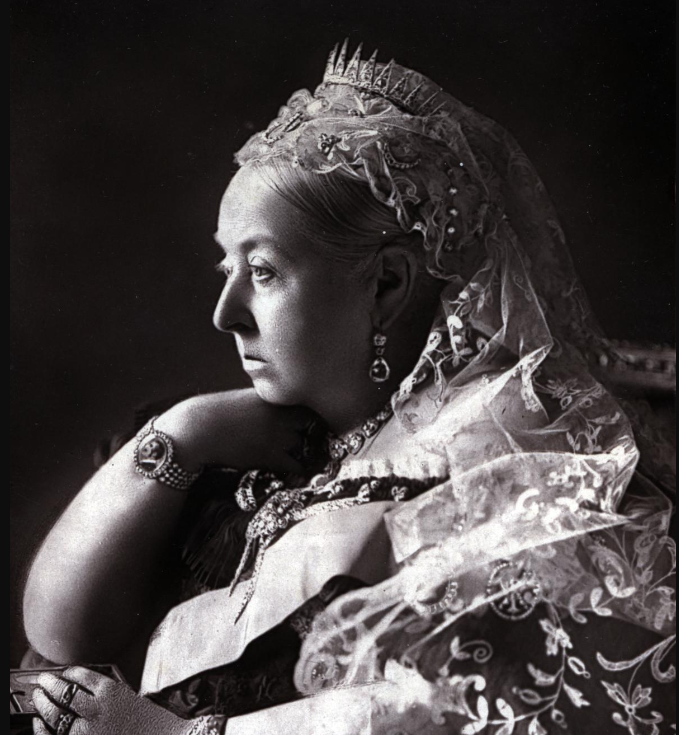
Heraldic Visitations began in 1530 and were tours of inspection undertaken by Kings of Arms in order to regulate and register the coats of arms of nobility and gentry, and to record pedigrees. By the fifteenth century many families were adopting coats of arms as symbols of wealth and power but not all had a legitimate claim to them. As surviving visitation records include pedigrees and often the evidence that was used to prove these, including family details, background and ages, their records provide important source material for genealogists.
Visitations records are currently available for individual counties and the whole of England and Wales, with years ranging from 1530 – 1921.
Poll Books & Electoral Rolls
Poll books detail names, addresses and occupations and show how people voted in the election. Our collection pre-dates the census records and goes back as far as the 1700’s making them a valuable resource for family historians.
Most records are searchable book images (printed Books), which can be searched by name or browsed by page with the aid of bookmarks, London 2005 and Queensland 1905 Electoral Registers are in database format and are searchable transcripts.
This database allows researchers to:
- Find ancestors who had the vote
- Discover where ancestors were registered to cast their ballot
- See the nature of their qualification to vote, such as owning rateable property
To access this resource:
From the Master Search page select Poll Books and Electoral Rolls from the Record Collection drop down menu:
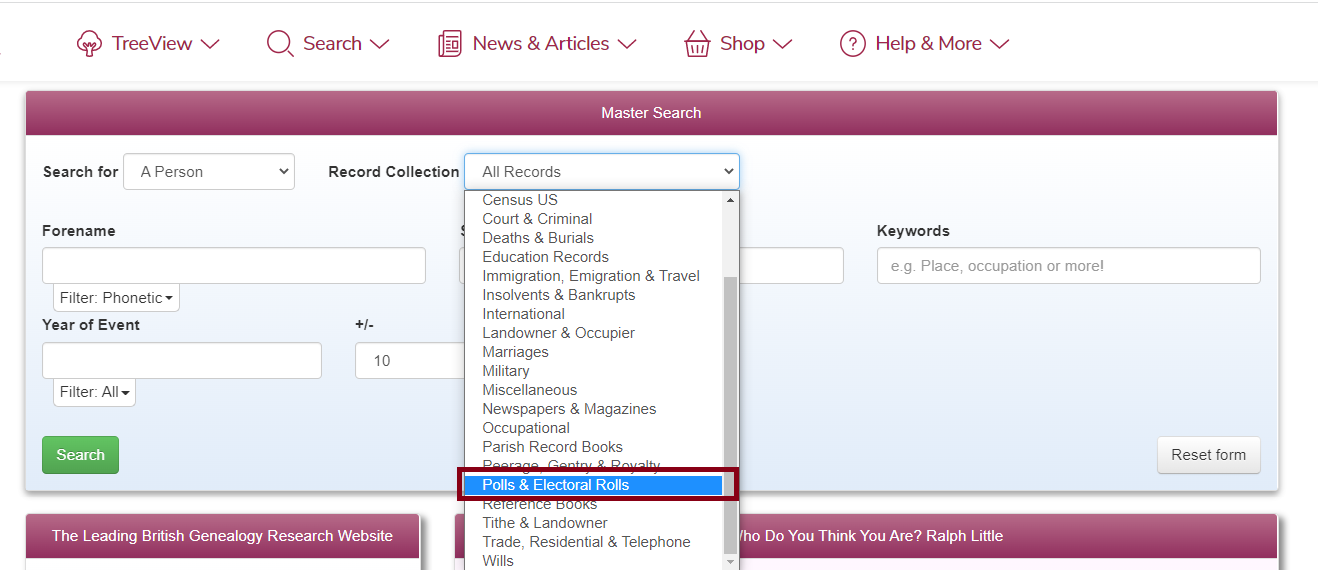
Alternatively you can use our Advanced Search facility; you can access this by clicking the ‘Search’ tab along the top of the website and choose 'Find Records'. Scroll down the page for a list of databases, and choose ‘Polls and Electoral Rolls’ and select the required option from the dropdown menu.
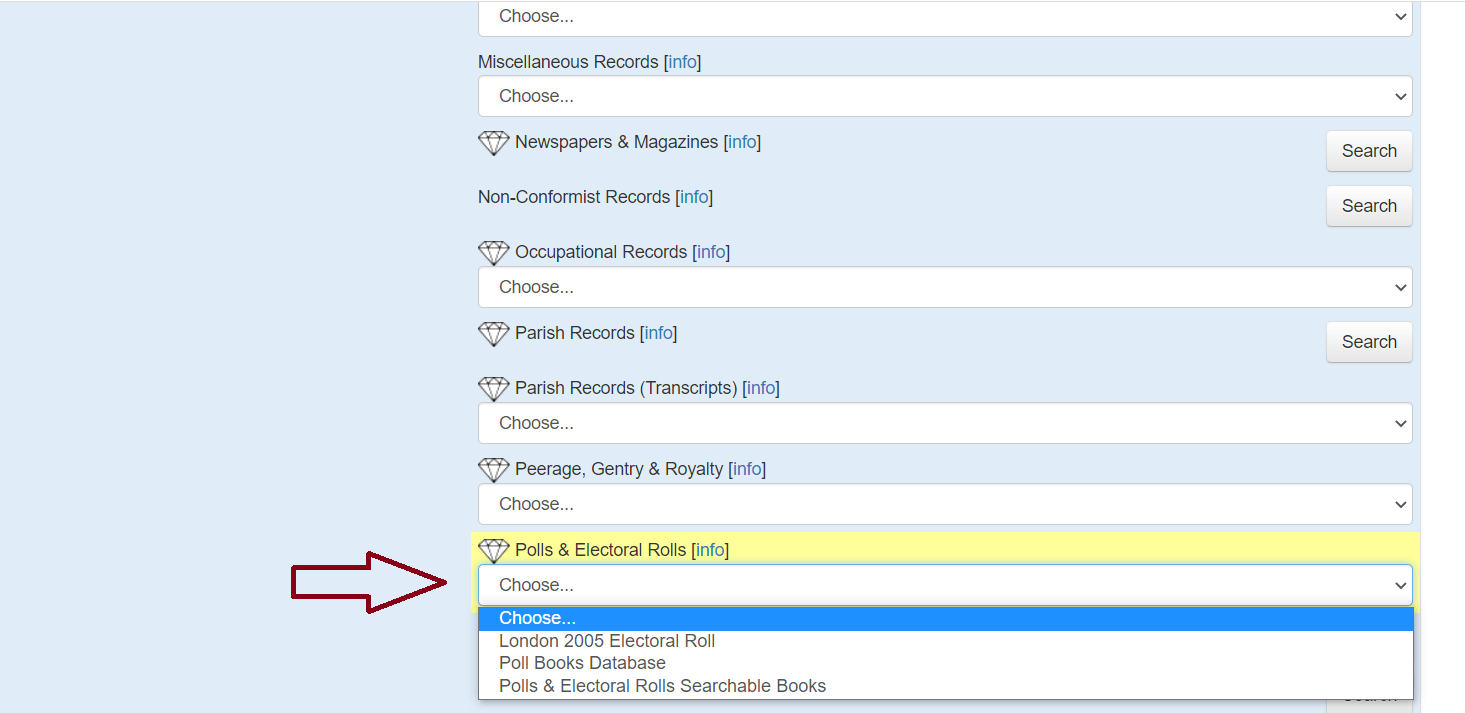
Here you will be able to search using a variety of search criteria. When searching the London Electoral Roll 2005 for example you can enter a person's name address and select the required district from the drop down menu:

When you select Poll Books Database, you can select a County and Year in addition to the entering the persons name:

Or choose a County to view the browsable books when you select Poll and Electoral Roll transcripts:
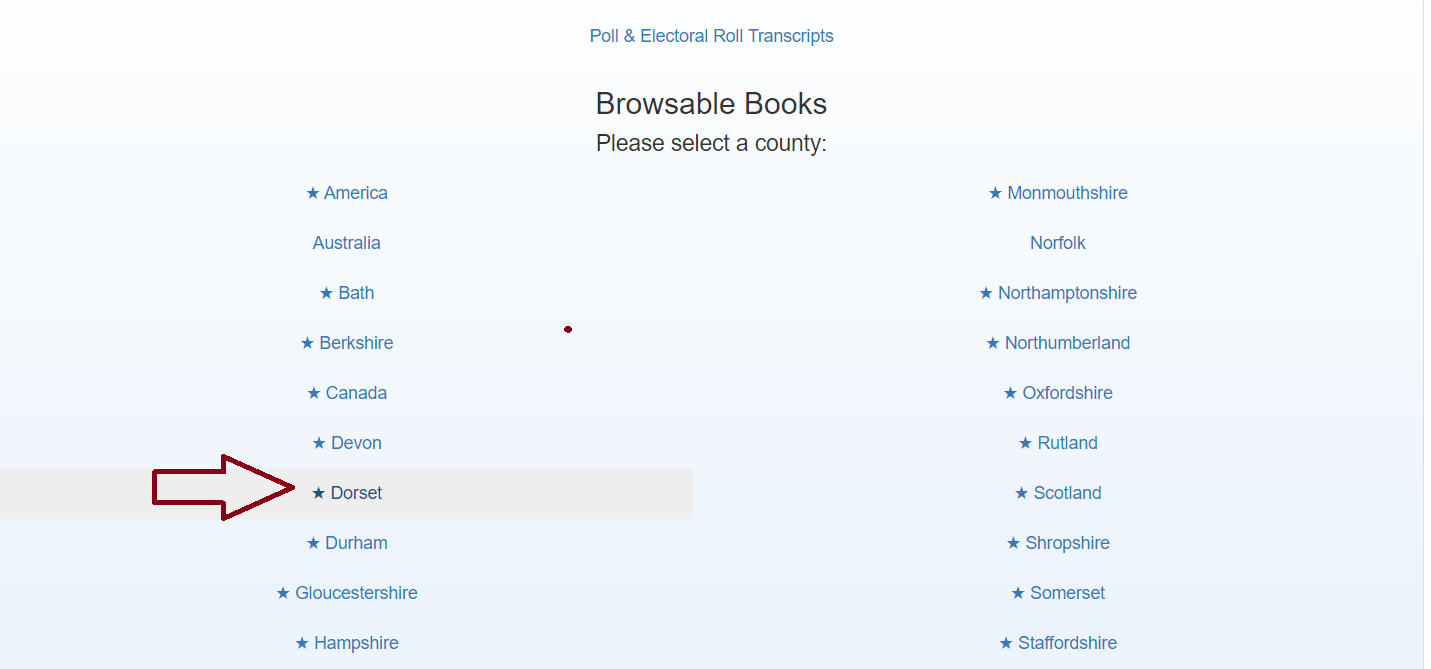
Trade and Residential Directories
Our collection of searchable Early Trade and Residential Directories cover the years 1816-1839 and can help to find ancestors in the period before the usable census records begin.
Prior to 1841 all of the U.K. censuses were generally statistical: that is, mainly headcounts, with virtually no personal information such as names recorded and so family history researchers need to turn to a substitute to find out the address where their ancestors had lived. Trade and Residential Directories list names of tradespeople, prominent citizens and in some cases other residents of a town as well.
Many of these directories will also give a good description of the town or area which can give family historians an interesting insight into the social history of their ancestors' locality at the time. This information usually includes the main industry, topographical details, communication links with the surrounding towns by stage coach or railway, and details of local administration offices, post offices, the clergy, charities, hospitals and schools.
Complementing the early UK Telephone Directory from 1899-1900 is the 1907 Post Office National Directory which adds a resource for finding names and addresses before the 1911 census. In addition, to the 1938 South Wales District Post Office Telephone Directory
Many commercial and trade directories (the forerunners of telephone directories) were published. Directories were first published for cities and large towns around 1800, and a few decades later for small towns or rural areas. However, there were earlier directories for London. A directory of London merchants was published in 1677 and London directories were published annually from 1734. The number of directories increased enormously during the 19th century. Some covered a county (or a number of counties), a city or even the whole of London. Others covered a few towns (perhaps a particular industrial area) or parts of London. The publication of directories continued until the 1970s when they were superseded by telephone directories.
Directories were originally aimed at commercial travellers and usually contained general descriptions of a city, town or village and its communications (stagecoach and railway connections). An entry for a place then listed its churches, schools, inns, Justices of the Peace, other prominent residents, farmers, shopkeepers and other traders. Advertisements from tradesmen were often included.
Directories of the 19th century are especially useful for finding the addresses of people who had their own business. This assists searches in the census records. Entries in directories of successive years may evidence changes of address or even change of business.
In addition to entries for trades and businesses, directories included some private residents.
Early directories included only the wealthier (or otherwise notable) private residents.. However, as the 19th century progressed, commercial directories not only became more comprehensive in their coverage of businesses, but also began to include the names and addresses of more private residents, whether or not they were wealthy or prominent. Directories with householders’ names and addresses also assisted the proper direction of post, and the Post Office’s own directories became increasingly important during the 19th century. By this time, directories were almost complete lists of the heads of households in residential areas.
To access the Trade, Residential and Telephone Directories from the Master Search select Trade, Residential and Telephone from the Record Collection drop down menu:

Or from Advanced Search page, you can access this by clicking the ‘Search’ tab along the top of the website, choose 'Find Records' then scroll down the list to select Trade, Residential and Telephone from the list of databases.

Wills, Probates and Testaments
Wills are a valuable source of genealogical information as they can give details of family members, places of residence and burial, as well as revealing details about their possessions.
Before 1858, England and Wales were divided into two provinces. The largest and most influential was Canterbury, which covered the South of England up to the Midlands and also Wales. The other was York, which covered Durham, Yorkshire, Northumberland, Westmorland, Cumberland, Lancashire, Cheshire, Nottinghamshire, and the Isle of Man. The two provinces of Canterbury and York each had their own Archbishop, and were divided into several dioceses. Each diocese had a minimum of two bishops, and these dioceses were also divided again into archdeaconries.
All wills, up until 12 January 1858, had to be proven in a church court to ensure that the will was legal. Wills were proven in over 250 church courts across the country, and the records of these are now stored mostly in local record offices.
Where a will was proved depended on which lands the property covered, and if it was contained within a single archdeaconry, then the will would be proven in the Archdeacon's court. If the property stretched across several archdeaconries, it would have to be proven in a Bishop's Court, or in the Archbishop's Prerogative Court if it covered more than one diocese. There were, however, occasional exceptions to this rule, such as if the person died abroad then the will would be proven at the Prerogative Court of Canterbury regardless of where the property was.
Locating Wills
Wills proven in the Prerogative Court of Canterbury are now held at the National Archives in Kew. TheGenealogist has transcribed the records so that they are available to access online.
Wills proven in the Prerogative Court of York are currently held at Bothwick Institute, part of the University of York.
All other wills up to 1858 are held in local record offices across the country, apart from those in Wales from 1521, which are held at the National Library of Wales in Aberystwyth.
Searching Will Indexes
The Will Indexes are listed by area on the Advanced Search page under 'Wills, Testaments and Probates'. Choose Wills and Testaments from the drop down menu then select the required area from the search page. You can either choose to browse the volume page by page and by using the bookmarks, or you can use the forename and surname search to enter the name of the person you are looking for. Our OCR system (Optical Character Recognition) turns the pages into searchable text, allowing you to enter search terms and bring back all the pages with matching results.
PCC Wills
There are over 1 million records in the Prerogative Court of Canterbury wills and probate collection, which covers the years 1384 to January 1858. The records are copies of registered wills, which were written into volumes by the clerks at the church courts, and many earlier records are in Latin.
An example, showing the will of author Jane Austin is detailed below:
http://www.nationalarchives.gov.uk/dol/images/examples/pdfs/JAusten.pdf
The records are searchable by name, year of will, year of probate, area and profession. The search results also show the image of the original record.
Using the PCC Wills
The PCC Wills are located on the Advanced Search page under 'Wills, Probates and Testaments', choose PCC Wills and Images from the drop down menu or available to search using the Master Search.
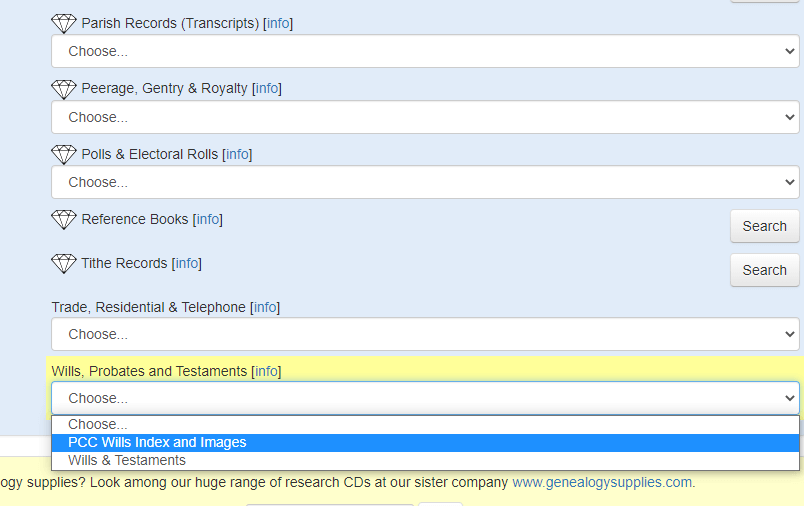
The Standard Search page provides a form which allows you to enter forename, surname and year of probate. To narrow your search down, you can also enter the Year of Will, Profession and Place. The year of probate relates to the year that the will was proven by the church courts, where-as the year of will is the date when the person actually recorded the will.
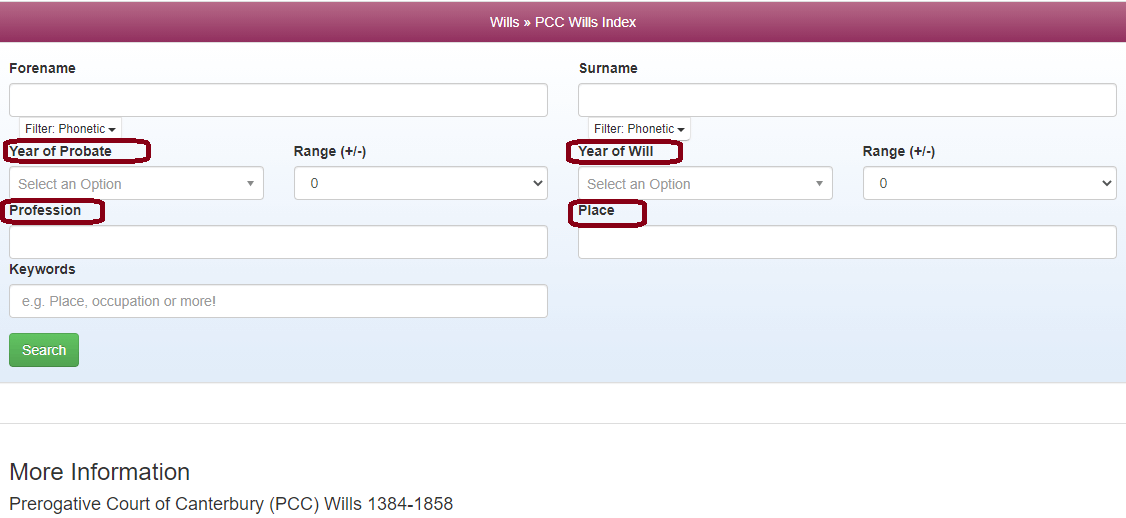
The results will be listed under the search box, and will show all the details included on the advanced search form. There are also links on the right of each entry, which allow you to submit a correction to our data team, open up the original page image, and also view the will as a printable transcript.
